A parcel service shipping method lets you create a paid shipping service using live rates from one of our integrated carrier partners.
If you’re not using live carrier rates and need to set up free or paid shipping options with pre-determined costs, skip this guide and create a custom service shipping method.
If you have a ShipStation subscription, learn how to connect ShipStation and create a shipping method that uses rates from your account.
You can add unlimited shipping methods – of any type – to each zone within any Scenario.
Add a Shipping Method
1) Click Shipping on the sidebar menu, then select Scenarios from the drop-down list.
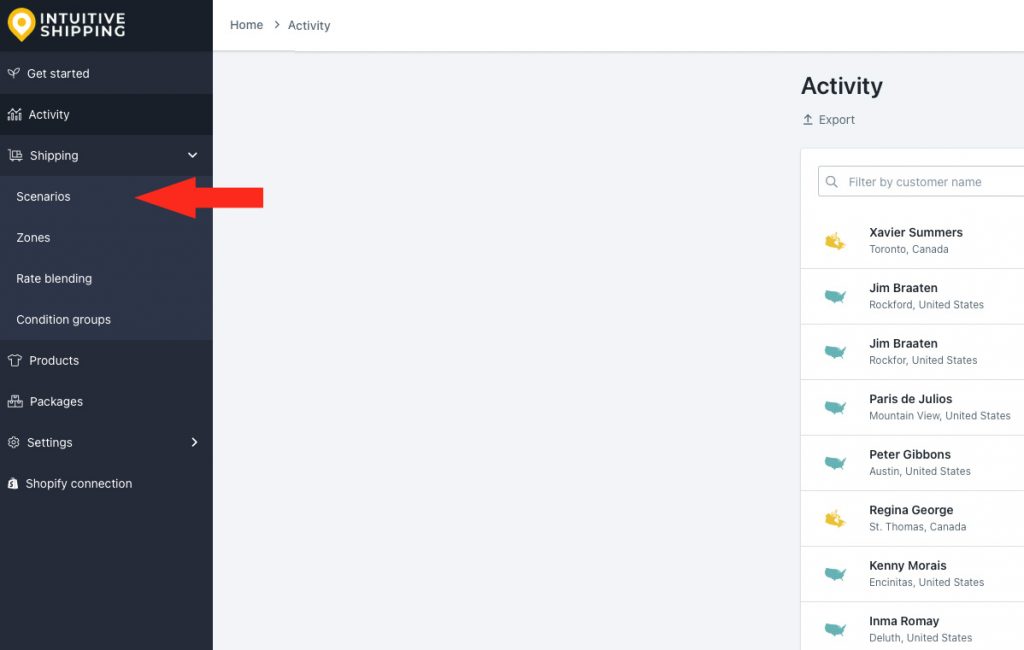
2) Click Edit beside the Scenario you wish to add the shipping method to.
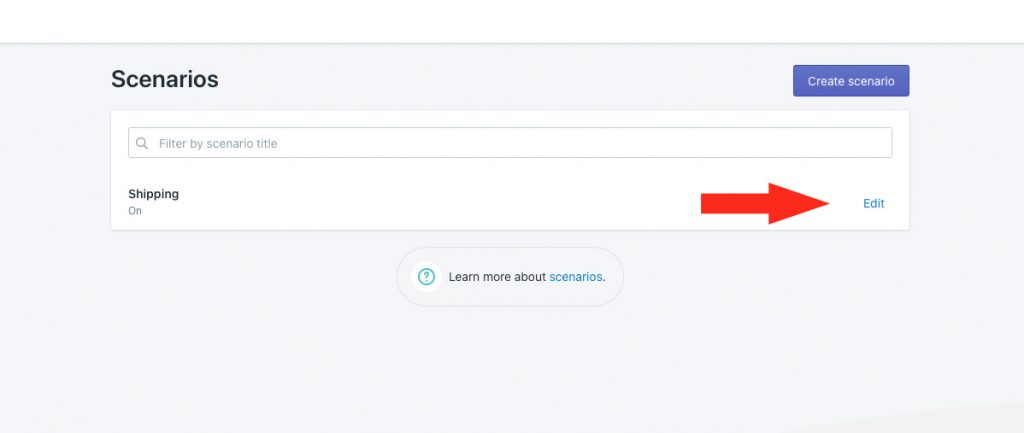
3) Scroll down to Shipping rates & services, then click the Create shipping method button.
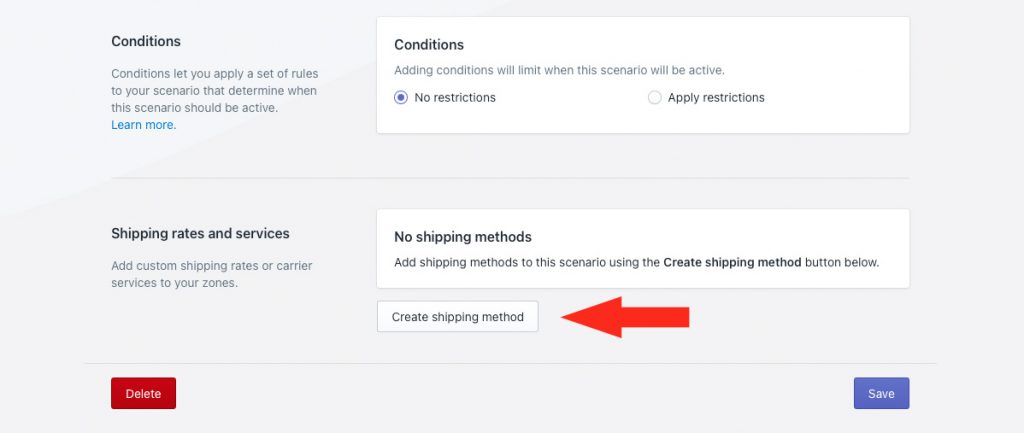
Select A Parcel Service
This guide will help you set up a paid shipping service with real-time rates directly from your preferred carrier.
1) Click the downward arrow beside ‘Parcel services’ to display a list of live rate carriers.
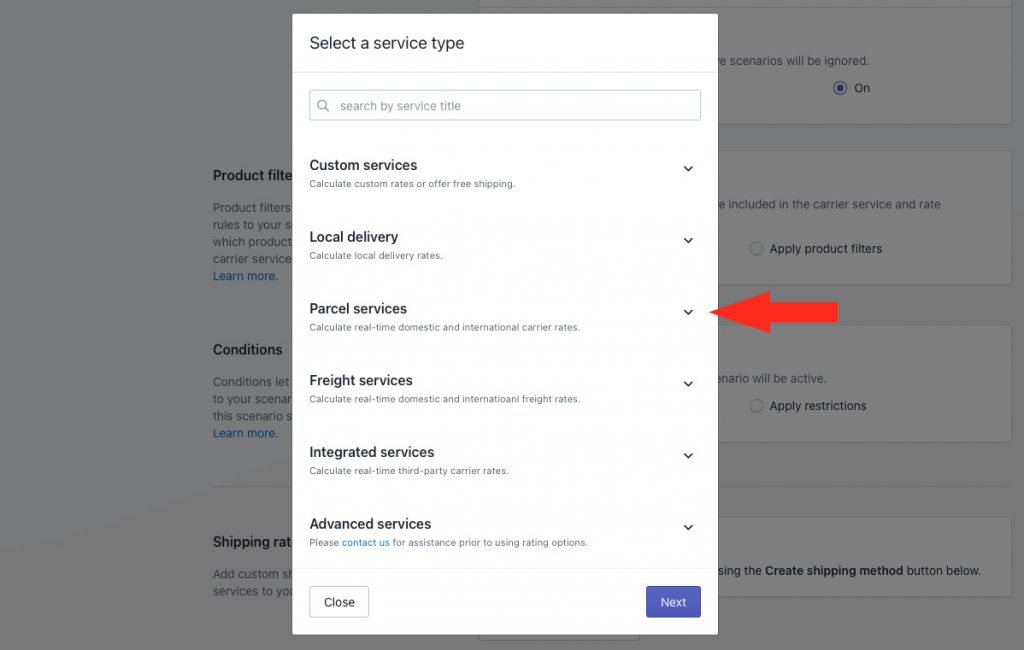
2) Select your preferred carrier from the list, such as Canada Post.
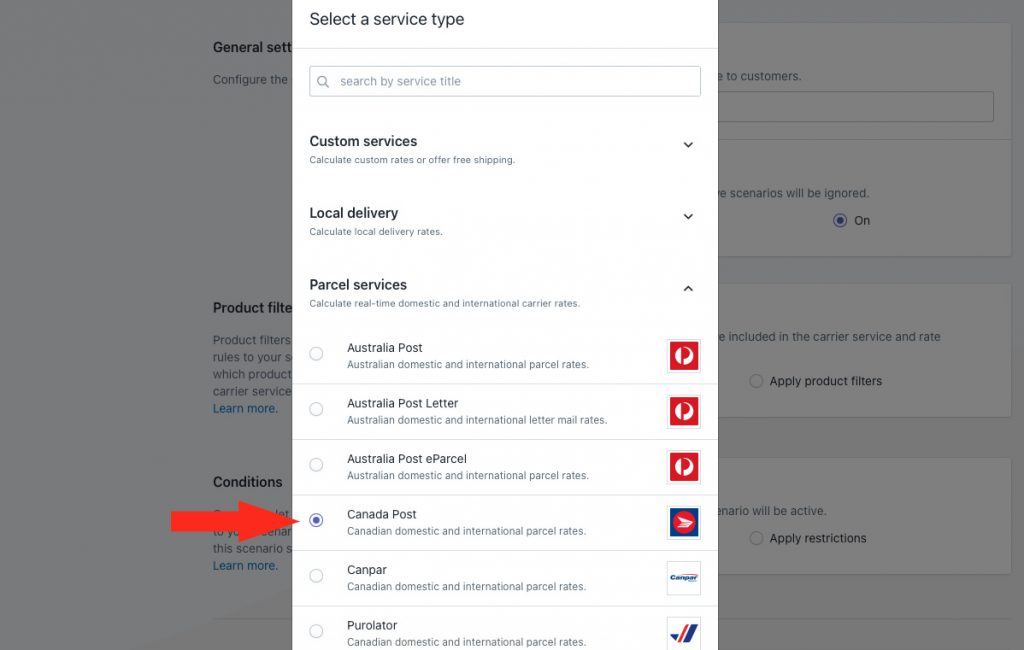
3) Click the Next button.
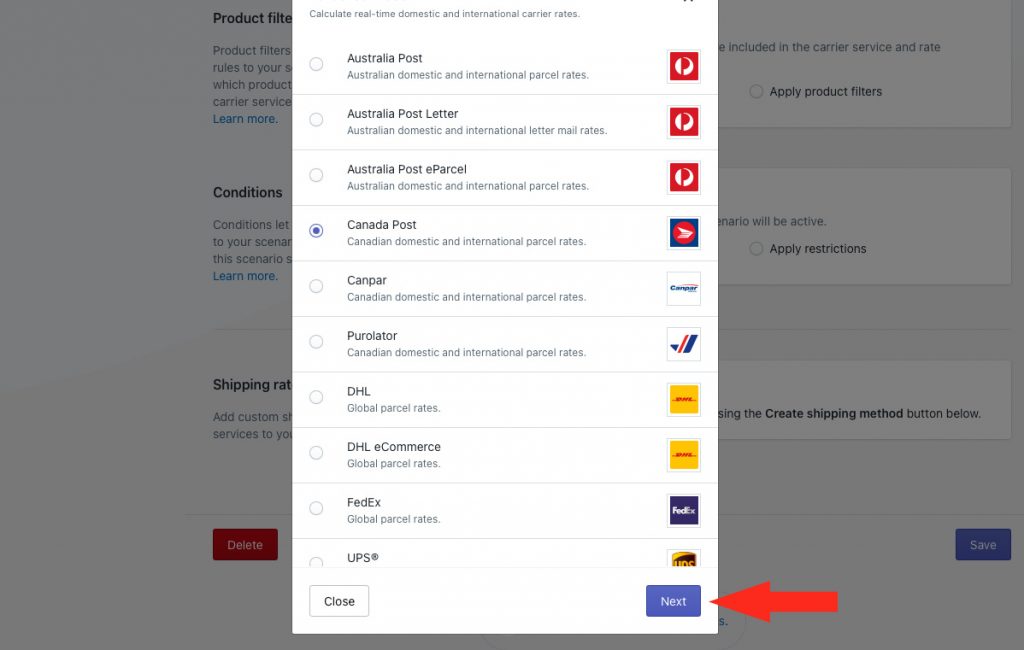
4) Select a Zone.
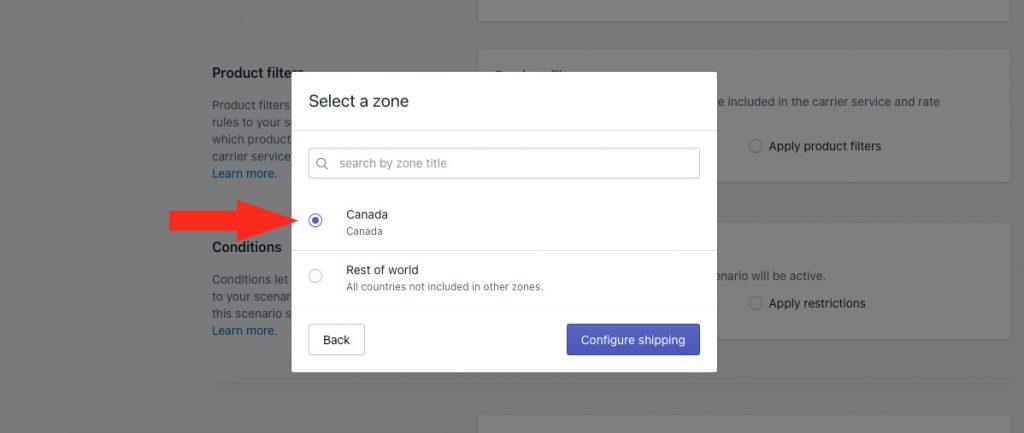
5) Click the Configure shipping button.
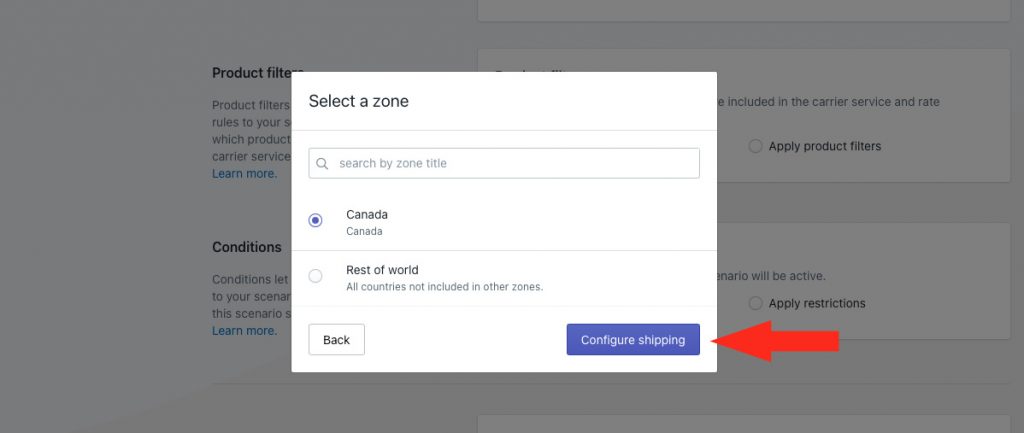
General
1) Enter a shipping method title. Depending on which setting you select in Step 2, the title entered here may or may not be visible to customers.
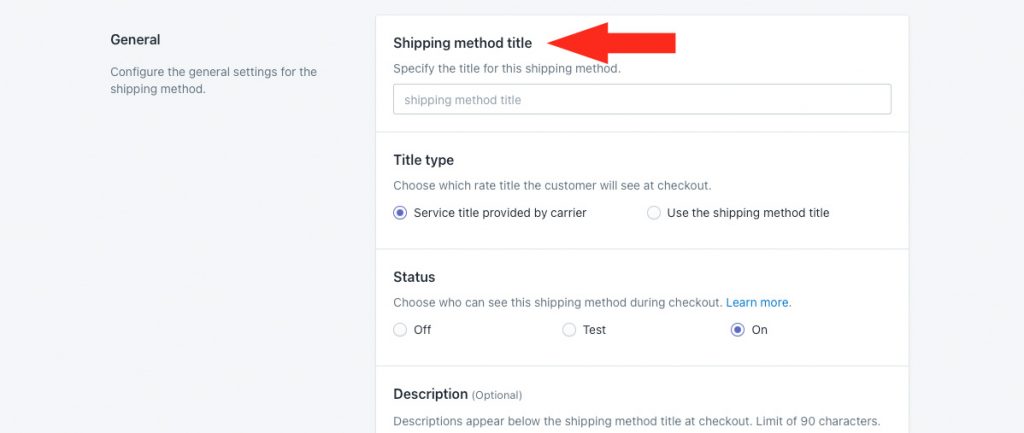
2) Choose the title type.
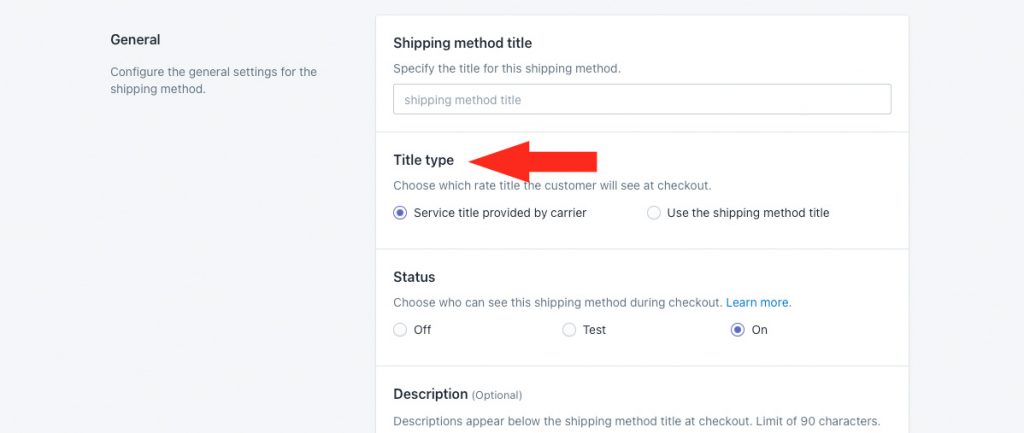
You have two (2) settings to choose from:
Service title provided by carrier – The service title (or titles) provided by the carrier in the rate calculation, such as ‘Canada Post Expedited Parcel’ or ‘Canada Post Priority’, will be displayed as the shipping method title (or titles) at checkout. This is the default setting.
Use the shipping method title – The shipping method title entered in Step 1 will be displayed at checkout. If you select multiple carrier service options, all of the service titles provided by the carrier are replaced with the shipping method title.
If you’re using Shopify, and multiple shipping methods with the same title are activated, Shopify removes duplicates and only displays the cheapest option at checkout. If you intend to provide customers with multiple carrier service options from the same shipping method (see Services below), we recommend using the service titles provided by the carrier.
3) Choose the shipping method status.
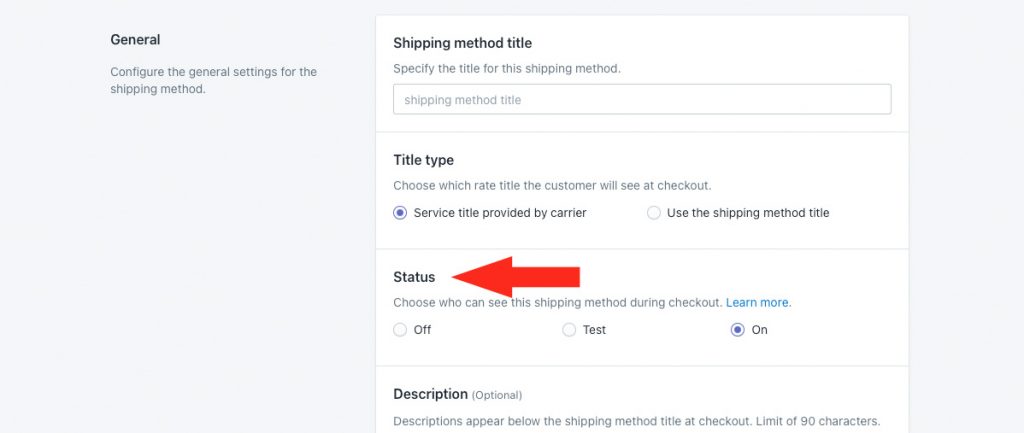
You have three (3) settings to choose from:
Off – The shipping method will be ignored by the Scenario it is assigned to, even if the Scenario conditions are met. The shipping method will not be displayed at checkout, even in Sandbox mode.
Test – The shipping method will only be visible at checkout when you use ‘Intuitive’ on the checkout page.
If you’re using Shopify, enter ‘Intuitive’ as either the customer’s first or last name.
If you’re using BigCommerce, enter ‘Intuitive’ in the optional address field for ‘Apartment/ Suite/ Building’.
On – The shipping method will be visible to customers. If the Scenario conditions are met, the shipping method will be displayed at checkout. This is the default setting.
4) If desired, enter a description for your shipping method. We recommend limiting your description to 90 characters or less to ensure it displays properly on the checkout page.
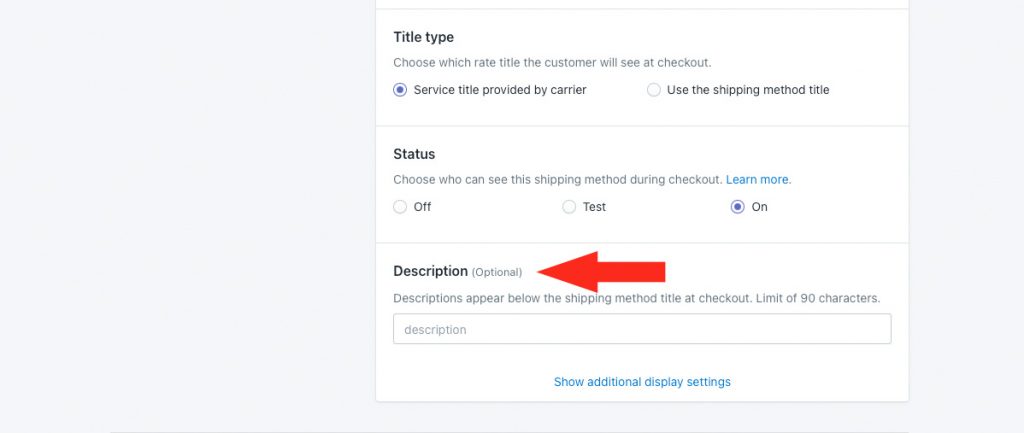
Additional display settings are available for delivery times, order processing times and service codes. If you do not need to adjust these settings, skip ahead to Packages. Otherwise, continue to Step 5.
5) Click Show additional display settings.
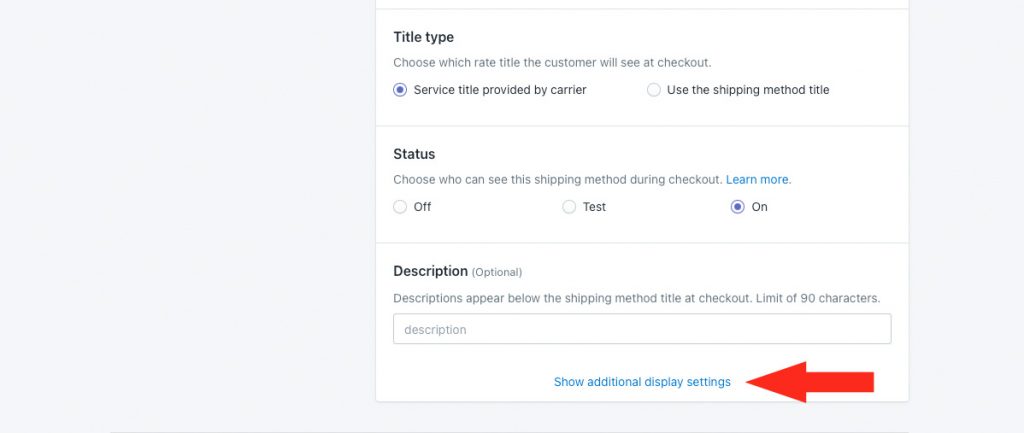
6) Choose whether or not you wish to have a delivery time displayed at checkout along with the rate. Delivery times are shown at checkout by default.
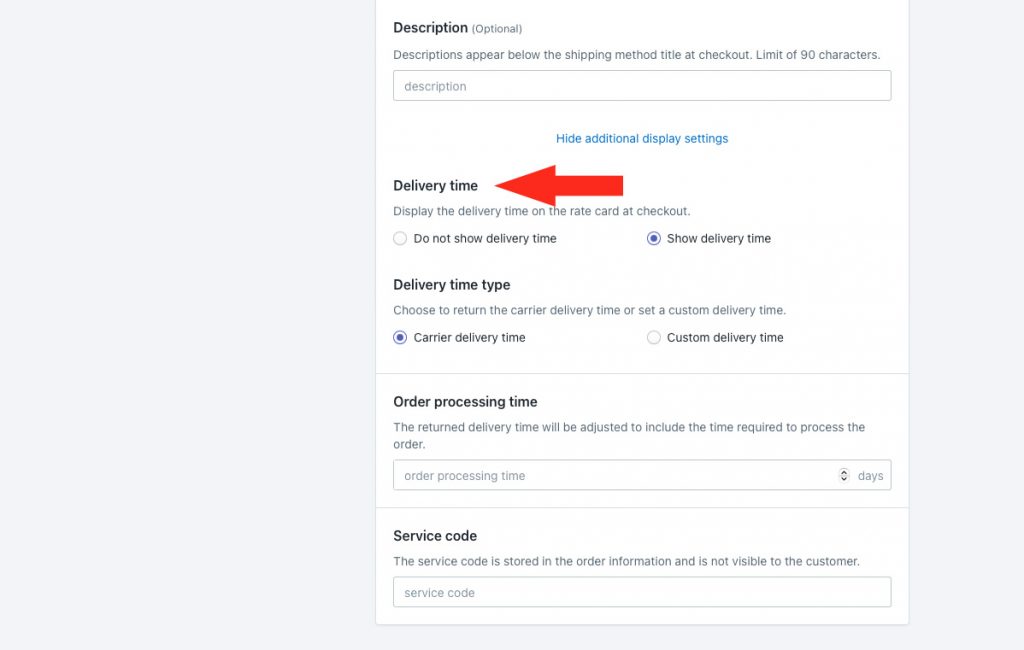
If you selected ‘Do not show delivery time’ in Step 6, skip ahead to Step 9. Otherwise, continue to Step 7.
7) If you’re planning to show delivery times, choose the type of delivery time you wish to have displayed at checkout.
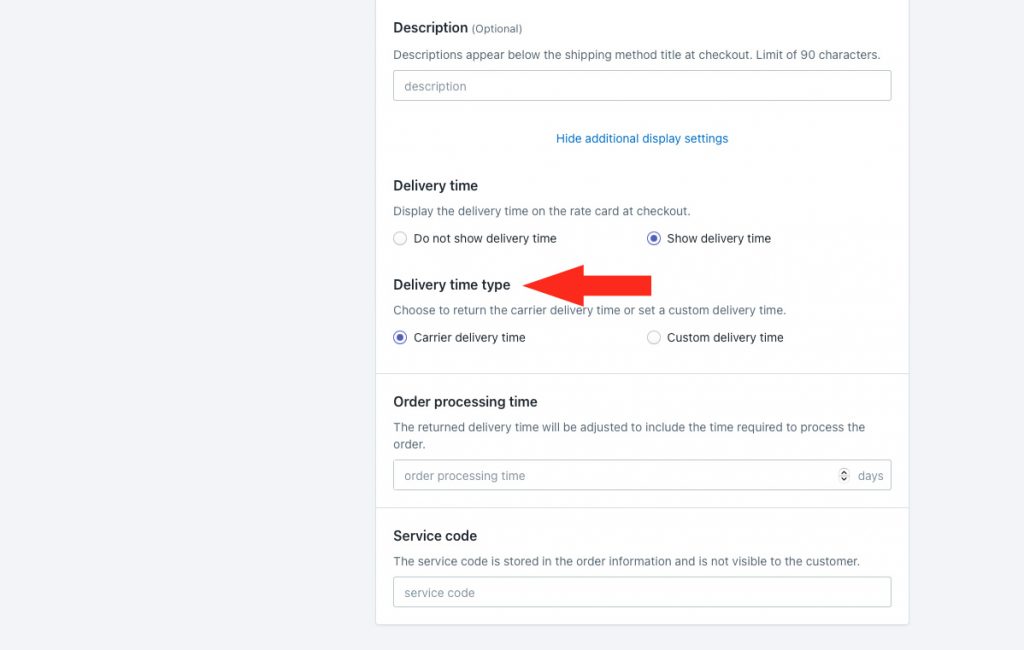
You have two (2) settings to choose from:
Carrier delivery time – delivery times displayed at checkout are estimates provided directly by the carrier along with the live rate calculation.
Custom delivery time – delivery times displayed at checkout are the values entered by you in Step 8. When you select this option, additional fields will appear on the screen.
8) If you selected Custom delivery time in Step 7, enter a minimum and, if desired, a maximum number of days.
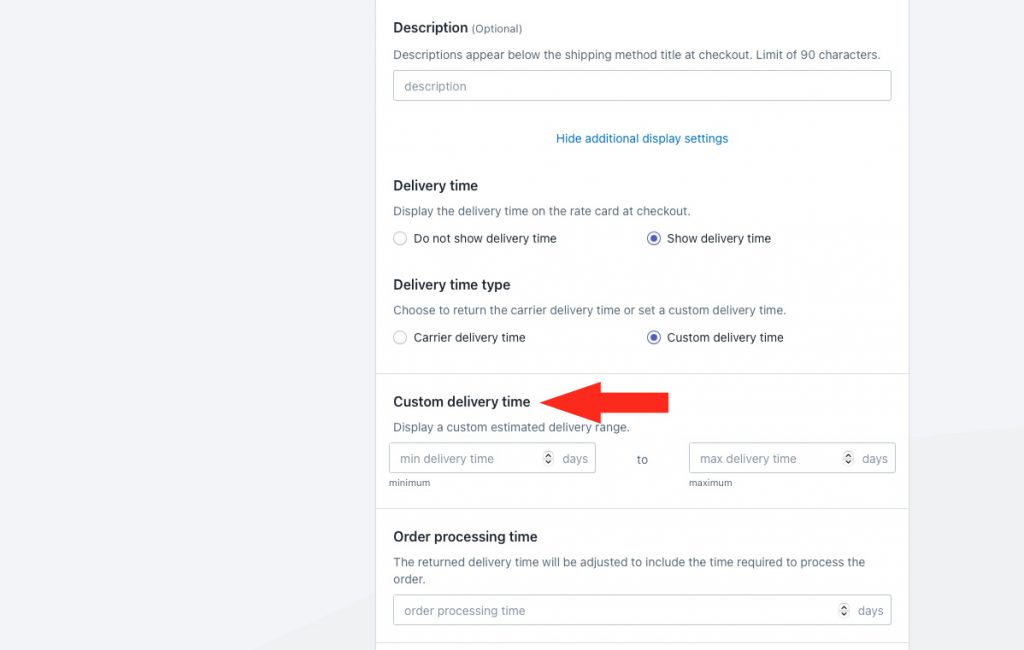
Min delivery time – enter the lower limit of your delivery time range.
Max delivery time – enter the upper limit of your delivery time range. When combined with the min setting, delivery times will be displayed like ‘3 to 5 business days’ at checkout.
For example, if you prefer to have delivery time displayed as ‘3 business days’ instead of ‘3 to 5 business days’, enter ‘3’ in either minimum or maximum and leave the other field blank.
9) If desired, add order processing time, in days. This is useful when you sell products that cannot be shipped out the same day the order is placed.
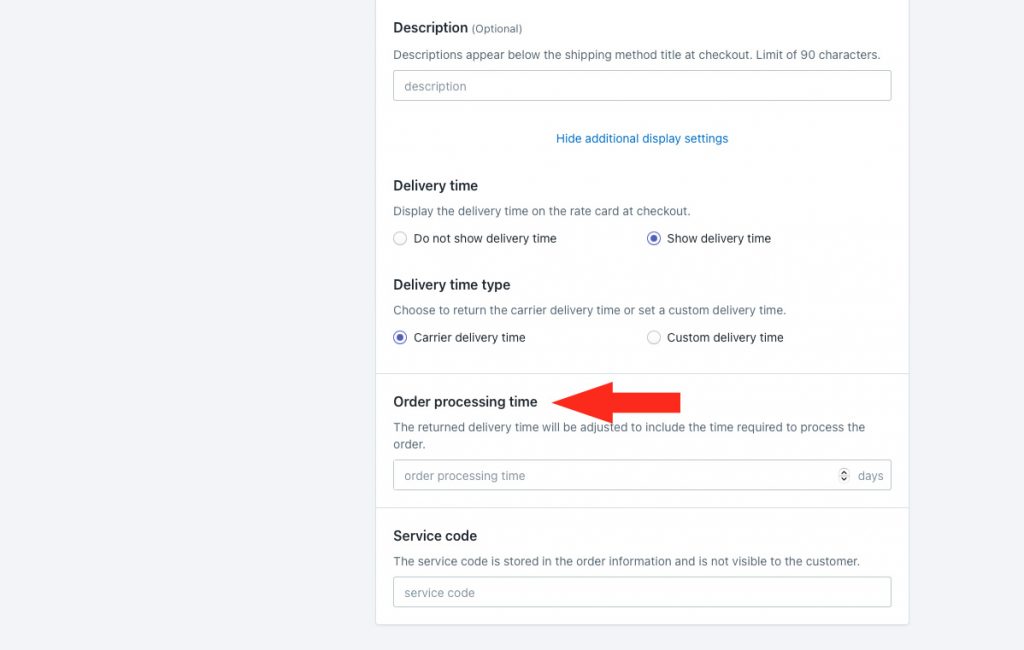
For example, if you enter 3 days for order processing and the carrier returns an estimated delivery time of 2 days, Intuitive Shipping will display the delivery time as ‘5 business days’ at checkout.
10) If desired, enter a custom service code, such as ‘GRD’. The service code is pushed to your fulfillment service (if applicable) when a customer successfully completes their checkout.
Entering a custom service code will override the service codes provided by the carrier. If you want to use the carrier-provided service codes, leave this setting blank.
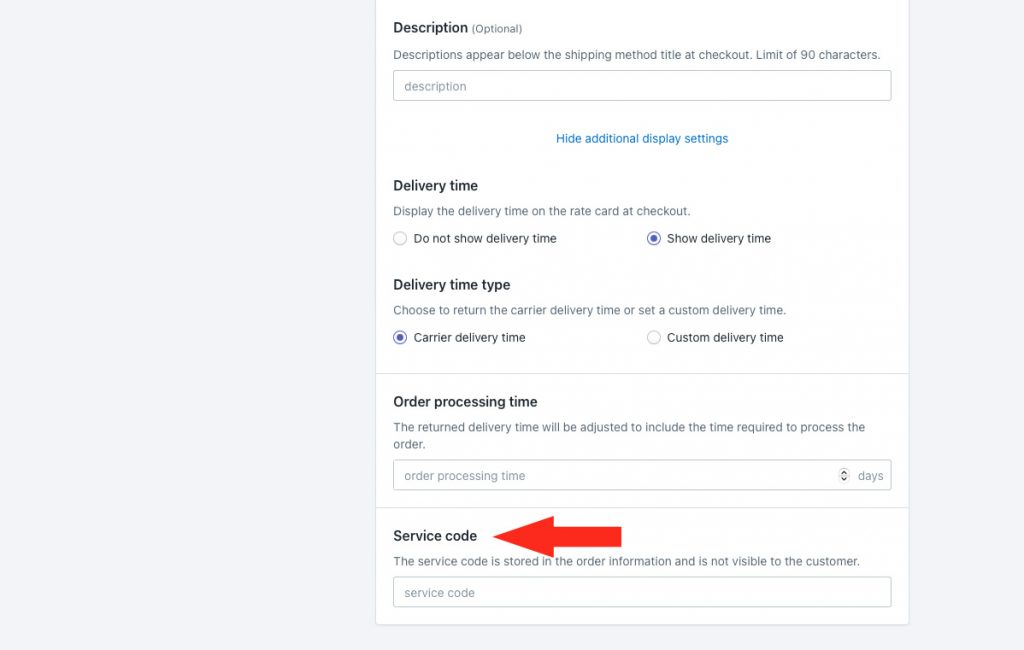
Packages
You can determine how the customer’s order will be packaged by selecting the appropriate packing algorithm and assigning the packages you want to be used by the shipping method.
1) Select a packing algorithm.
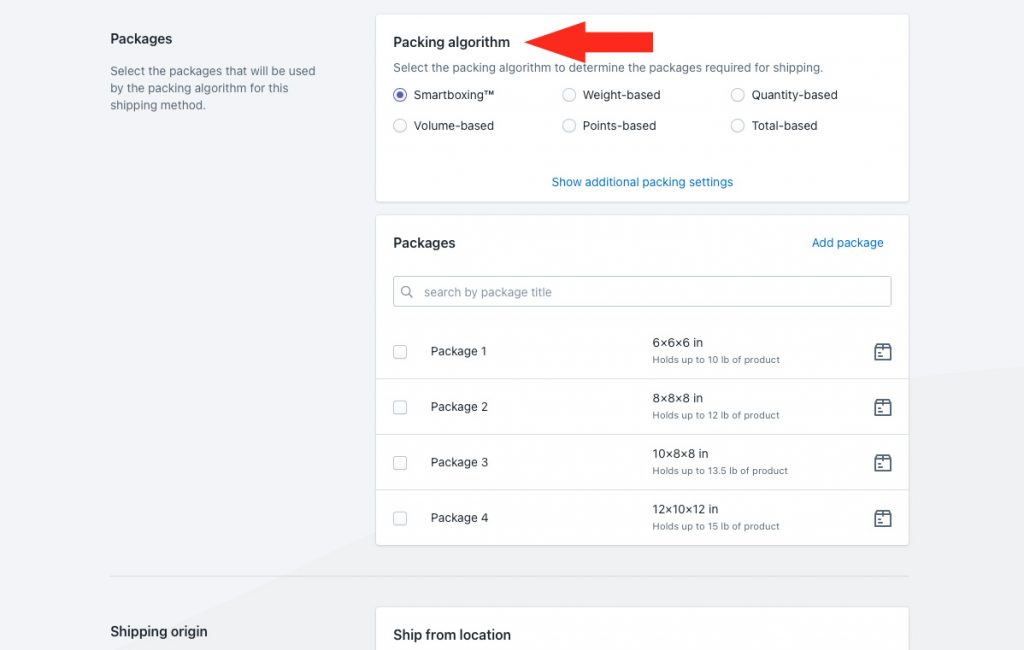
Your have six (6) options to choose from:
SmartBoxing™ – Intuitive Shipping will select the best package combination based on the weight and the dimensional volume of the order.
Weight-based – Intuitive Shipping will select the best package combination based only on the weight of order.
Quantity-based – Intuitive Shipping will select the best package combination based only on the number of items in the order.
Volume-based – Intuitive Shipping will select the best package combination based only on the dimensional volume of order.
Points-based – Intuitive Shipping will select the best package combination based on a point system.
Total-based – Intuitive Shipping will select the best package combination based only on the total value of order.
Additional packing settings are available for packing methods and multiple package blending. If you do not need to adjust these settings, skip ahead to Step 6. Otherwise, continue to Step 2.
2) Click Show additional packing settings.
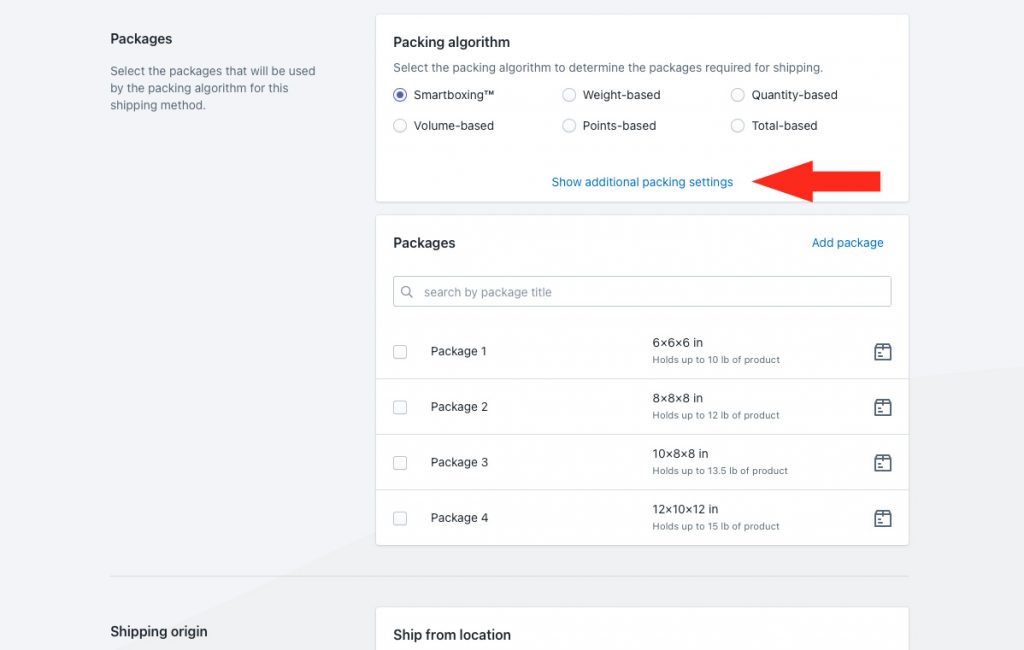
3) Select a packing method.
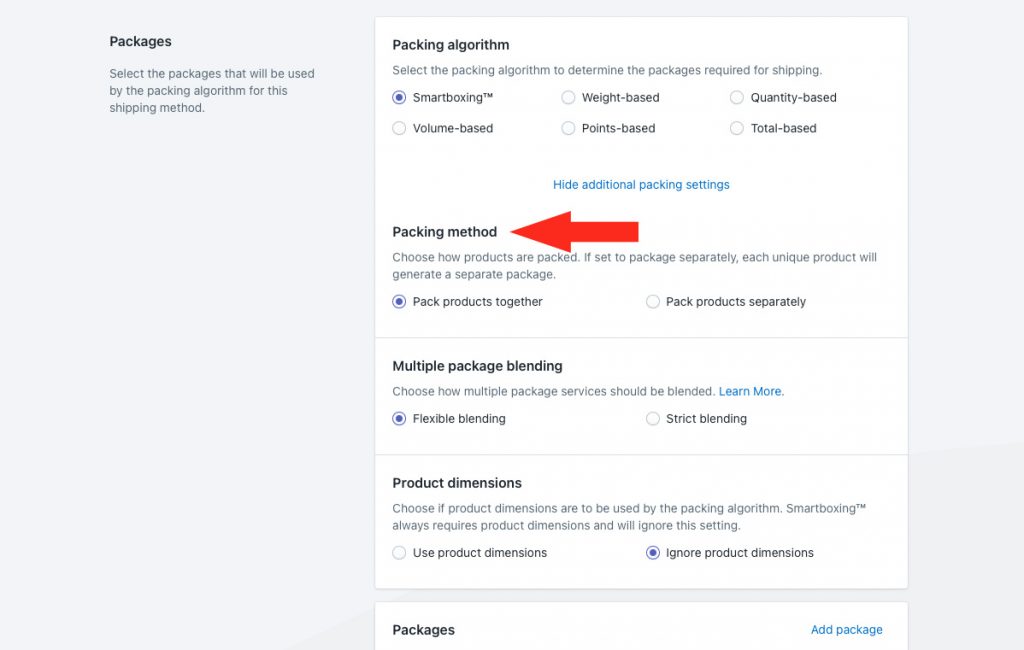
You have two (2) settings to choose from:
Pack products together – all of the products in the order will be packed together. Packages will be split based on the selected packing algorithm and the packages assigned to the shipping method. This is the default setting.
Pack products separately – each product in the order will be packed separately based on the selected packing algorithm and the packages assigned to the shipping method.
For example, if you select ‘Pack products separately’ and a customer orders 3 black hats, 2 yellow t-shirts and 1 red hoodie, the black hats will be packed together in their own package set, the yellow shirts will be packed together in their own package set, and the red hoodie will be packed in its own package.
4) Choose how multiple packages will be blended when carrier services don’t match.
Occasionally, packages in the order may not qualify for the same carrier service. In the event that this happens, the costs of each package will be blended according to this setting.
For example, if Package 1 only qualifies for service A and Package 2 only qualifies for service B, the flexible setting will blend them together. The strict setting will not return a shipping cost.
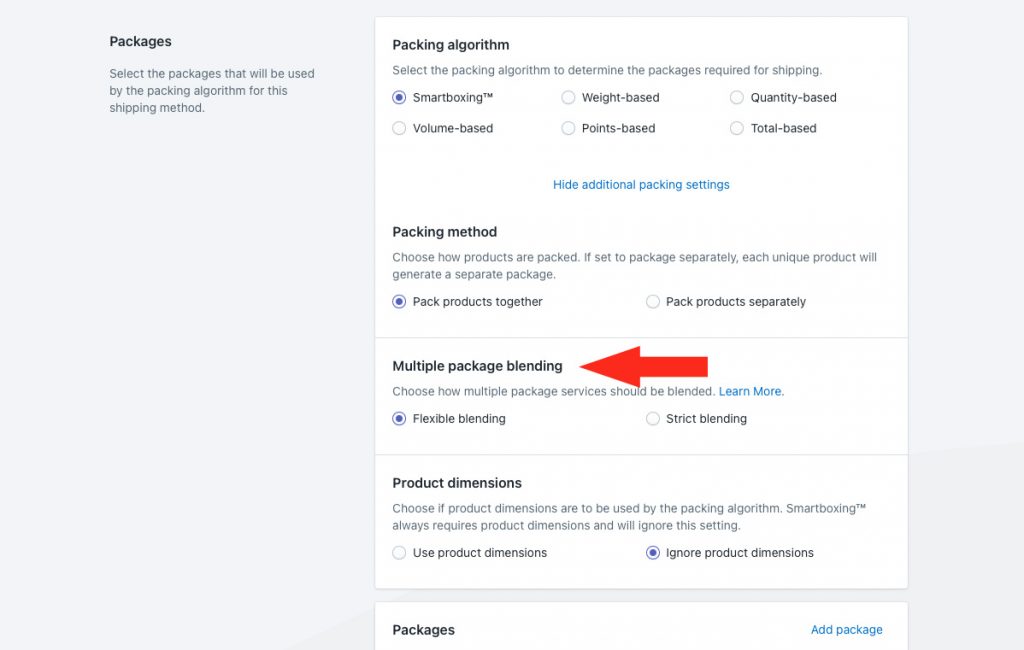
You have two (2) settings to choose from:
Flexible blending – an attempt will be made to blend costs based on services. The lowest cost for each package will be blended together if packages do not have matching services. This is the default setting.
Strict blending – costs will be blended only if all packages have matching services. No costs will be returned if packages do not have matching services.
For example, if a customer orders 3 products – one qualifies for USPS Priority Flat Rate Medium, while the other 2 products do not – flexible blending will blend the Flat Rate costs with the other services. Strict blending will not allow costs to be blended or displayed.
5) Choose whether or not product dimensions should be ignored. This is useful if you have products with one or more dimensions that exceed the dimensional limits of certain packages, regardless of the packing algorithm.
For example, while the SmartBoxing™ algorithm uses both product size and weight to optimize the package set, it considers the total dimensional volume (length x width x height) for size. It does not consider individual dimensions.
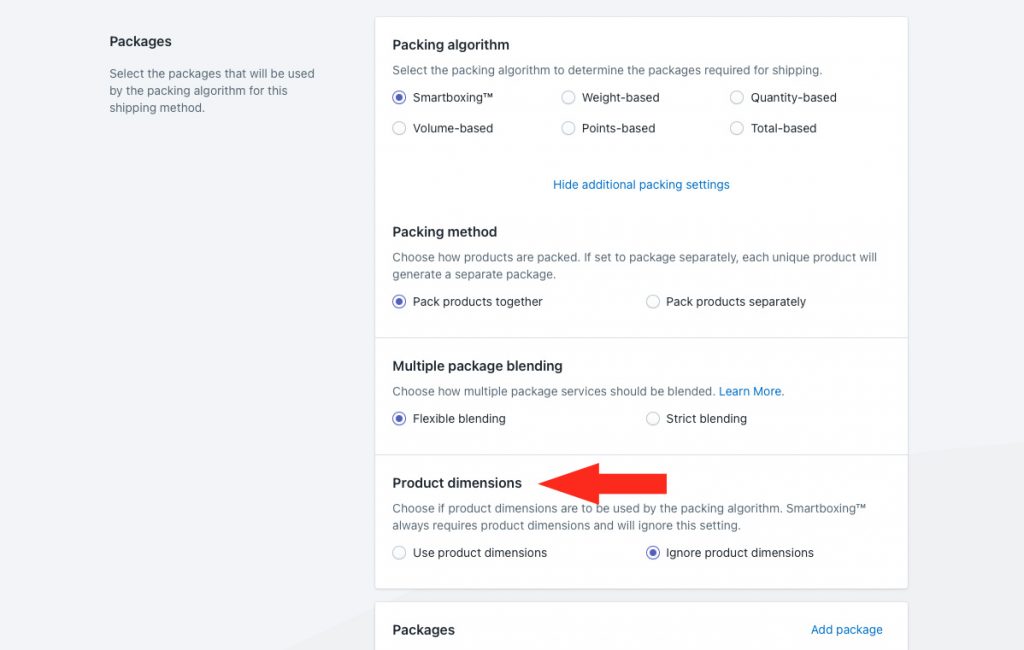
You have two (2) settings to choose from:
Use product dimensions – product dimensions are checked to ensure every product in the cart fits in the selected packages, regardless of the packing algorithm selected in Step 1.
Let’s say you’re using SmartBoxing™. You have a package that is 12 x 10 x 8 inches, for a total volume of 960 cubic inches. When a customer orders a product that is 6 x 15 x 3 inches, the package will not be selected because the product width (15 inches) is greater than any of the package dimensions, even though the total volume of the product (270 cubic inches) is much less than the package can hold.
This setting works well when you have rigid product dimensions that cannot be manipulated.
Ignore product dimensions – individual product dimensions are not considered, and packages are selected strictly based on the packing algorithm selected in Step 1.
Using the same example, when a customer orders a product that is 6 x 15 x 3 inches, the package will be selected because the total volume of the product (270 cubic inches) is less than the 960 cubic inches the package can hold.
This setting works well when you have products that are flexible, meaning they can be bent, curved, folded or otherwise manipulated to fit into the box.
All of the packages saved to your central Packages settings will be listed in the Packages section of the shipping method as selectable options. If desired, you can also add a package directly from the shipping method.
If all of the packages you want to assign to the shipping method are listed, skip ahead to Step 16. Or, continue to Step 6 to add a package.
6) To add a package that is not currently listed, click Add package.
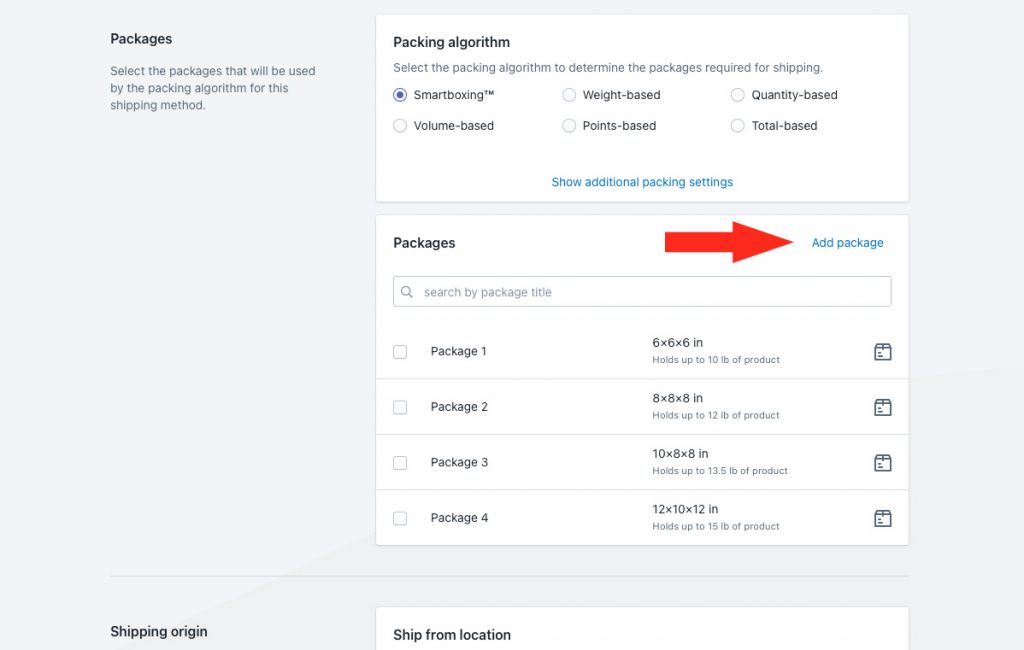
7) Enter a package title, like ‘Box 1’ or ‘Large Envelope’.
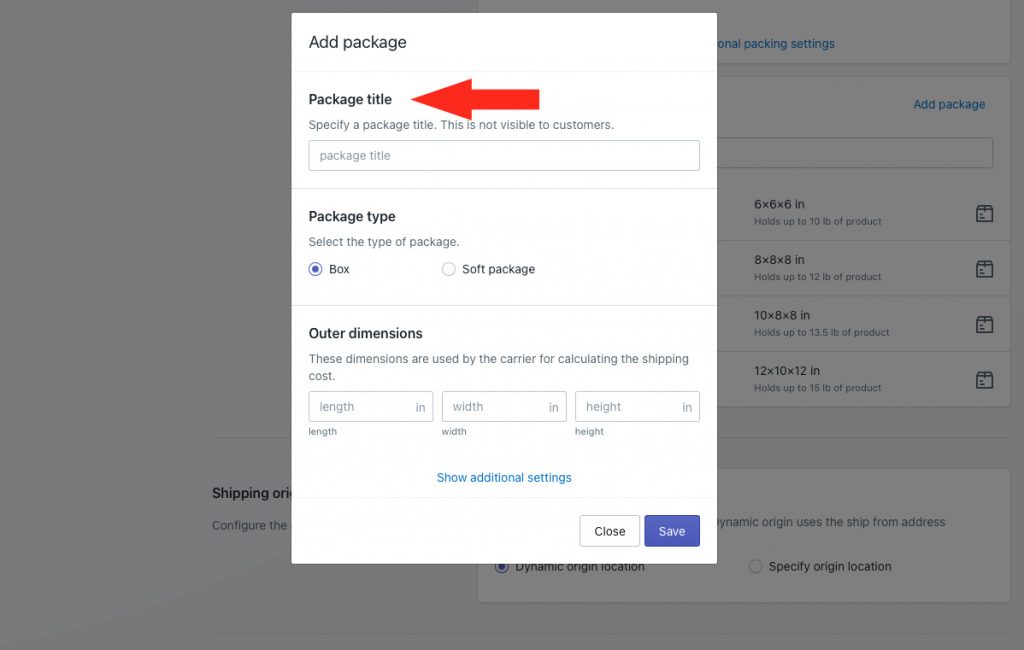
8) Select a package type.
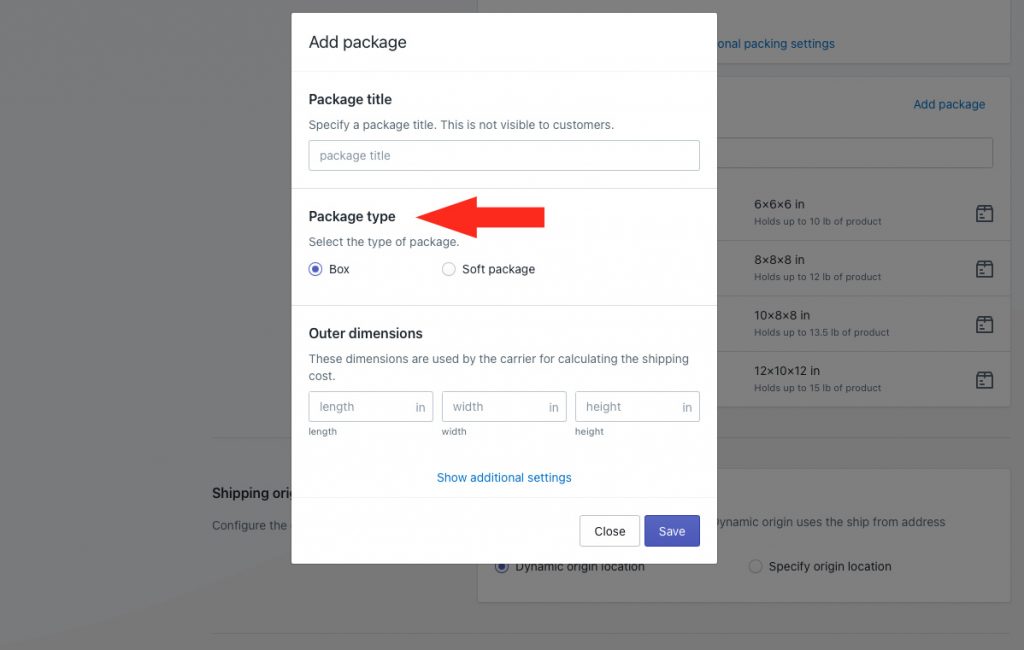
You have two (2) settings to choose from:
Box – a rigid container with fixed dimensions.
Soft package – a flexible container with fixed length and width, and adjustable height.
9) Add the outer Length, Width and Height of the package. These dimensions are used by the carrier service to calculate the shipping cost.
If you selected Soft package in Step 8, the height dimension is the maximum height. Intuitive Shipping will automatically adjust this dimension based on the size of the products being packaged.
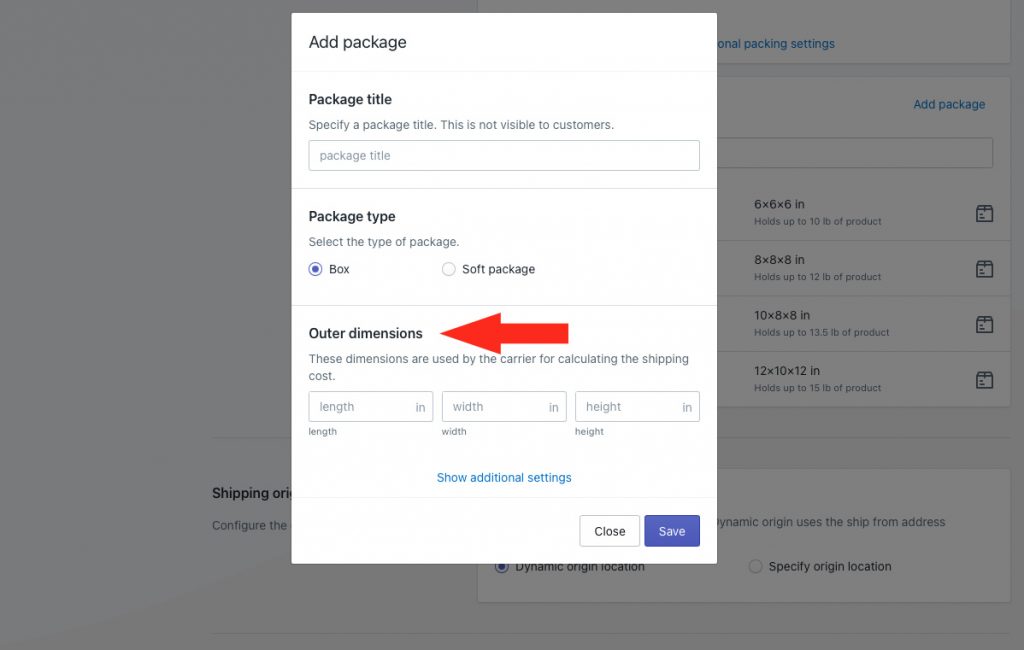
Additional settings are available for inner dimensions, maximum weight, empty weight and package cost. If you don’t need these settings, skip ahead to Step 16. Otherwise, continue to Step 10.
10) Click Show additional settings.
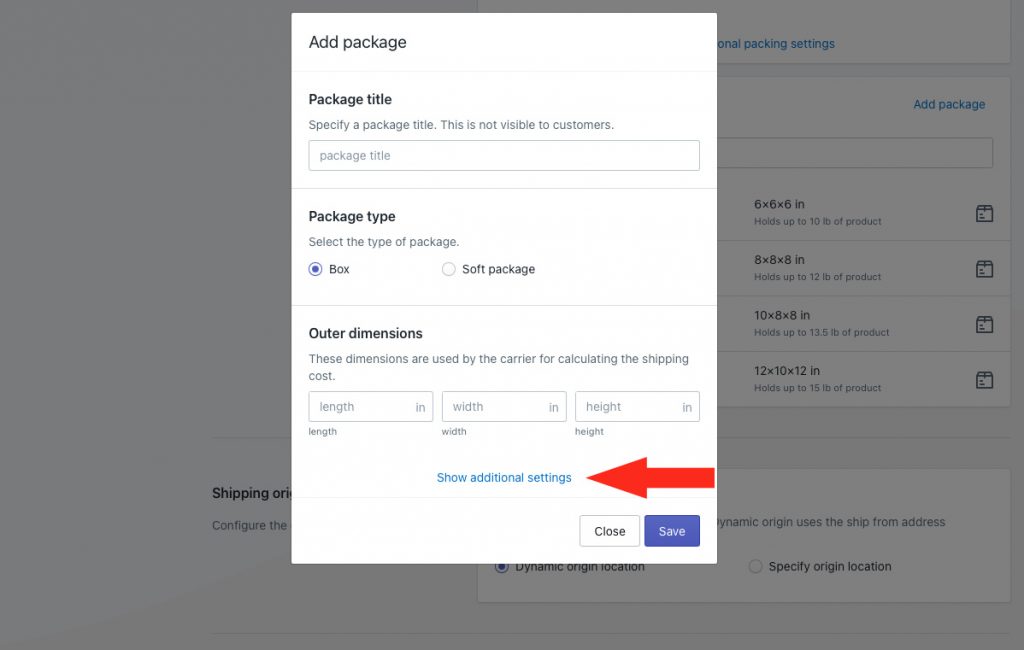
11) If desired, add the inner Length, Width and Height of the package. These dimensions provide greater accuracy for SmartBoxing™ when there is a tangible difference between the inner and outer dimensions or when extra packing material is required.
Inner dimensions can also be used with simple packing algorithms like weight-based or quantity-based packing if products in the order have been assigned dimensions.
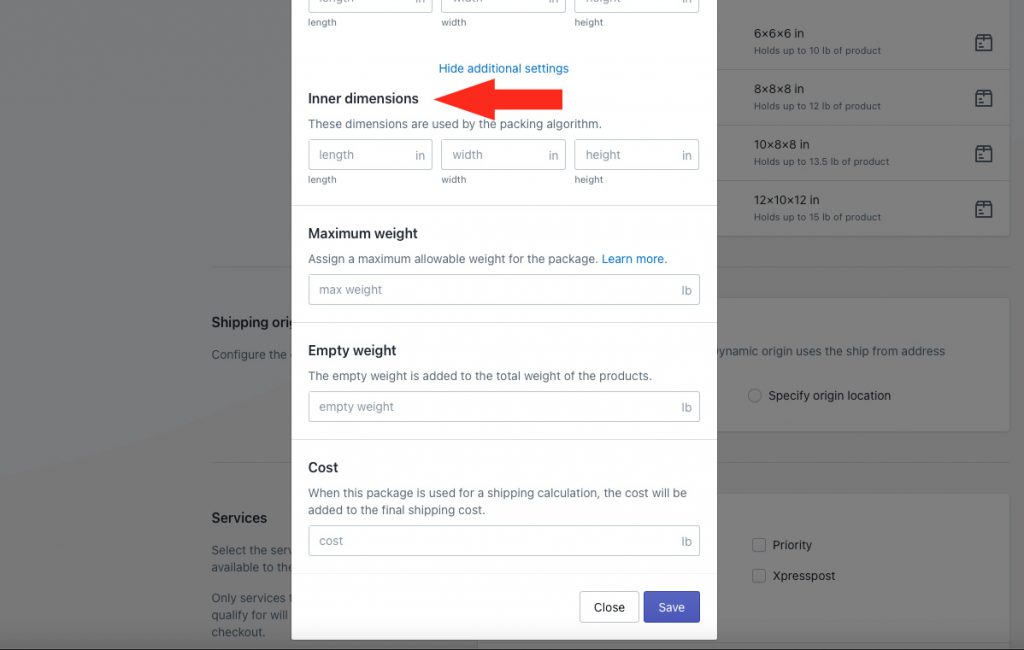
12) If desired, enter the maximum weight of the package. When specified, Intuitive Shipping will ensure that the combined product weight does not exceed this amount for a single package.
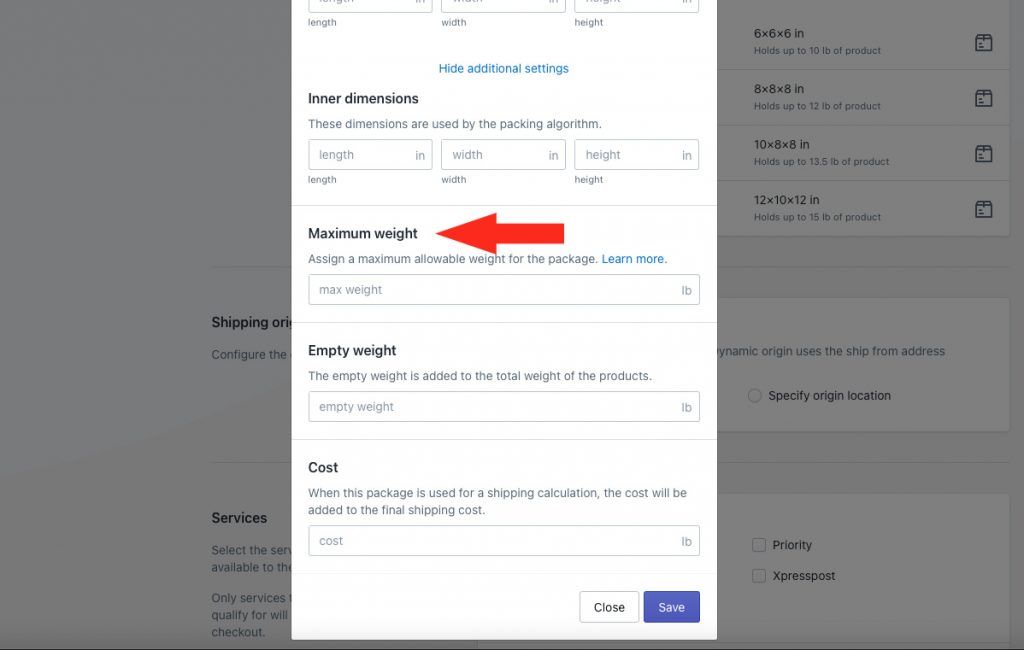
13) If desired, enter the empty weight of the package. When specified, Intuitive Shipping will add this weight to the total weight of the products.
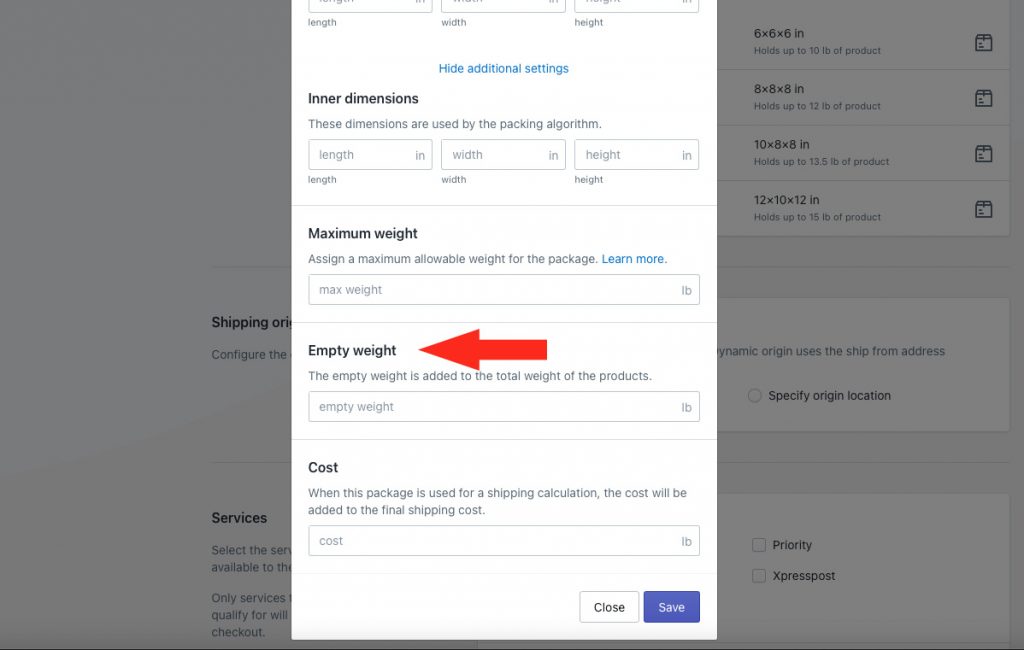
14) If desired, enter the cost of the package. When specified, Intuitive Shipping will add this cost to the total shipping cost.
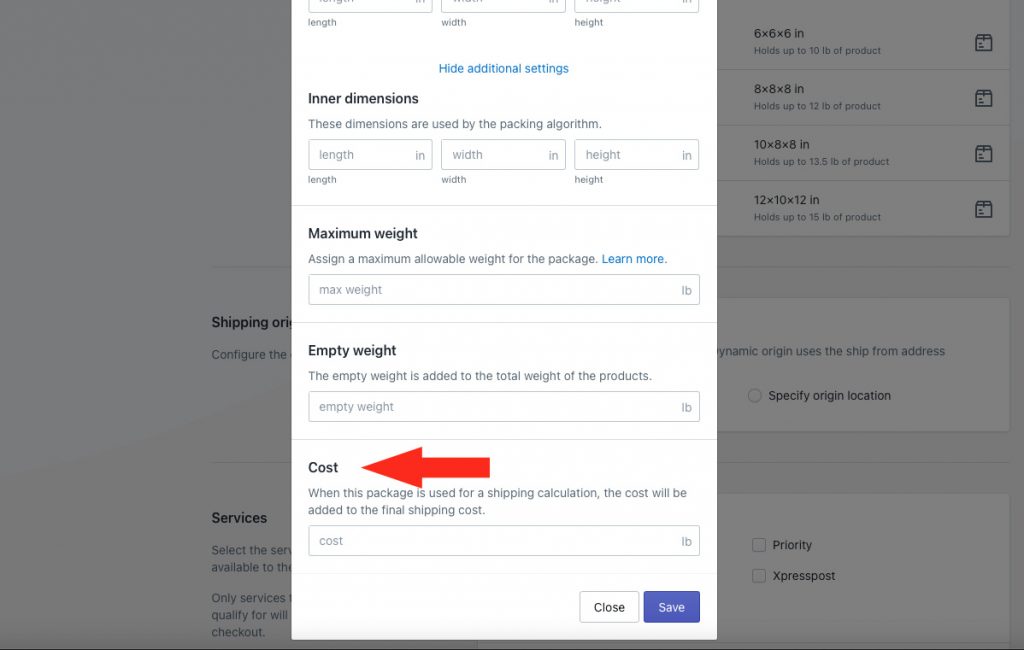
15) Click the Save button.
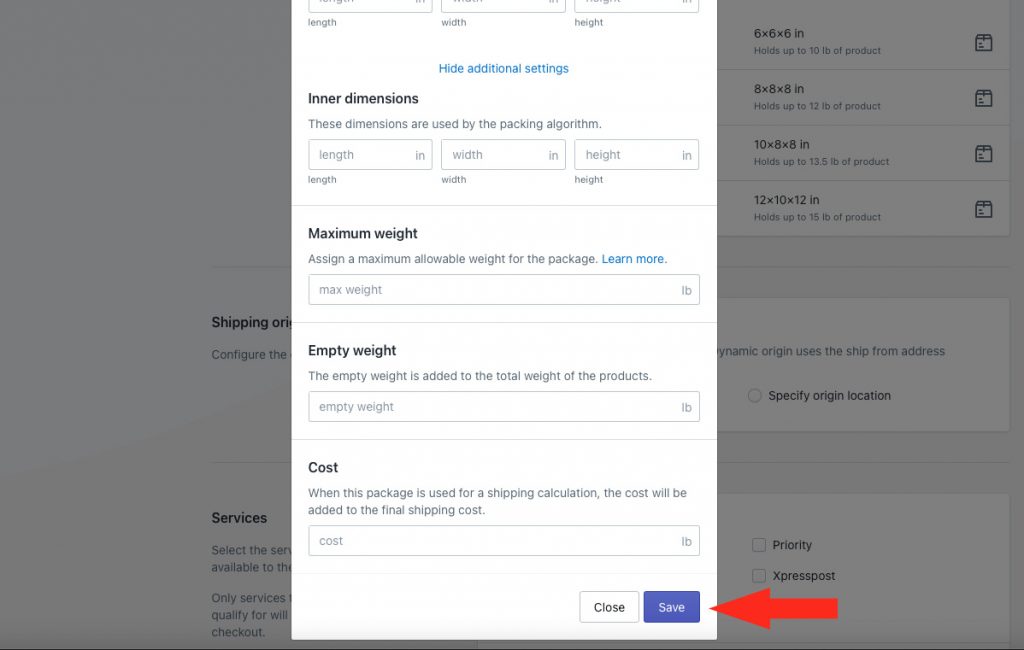
16) Select the packages you want to be included in the parcel service shipping method.
All of the packages saved to your central packaging settings are listed in the shipping method. To include all of your packages, select Custom Packages, which behaves like a ‘select all’ feature.
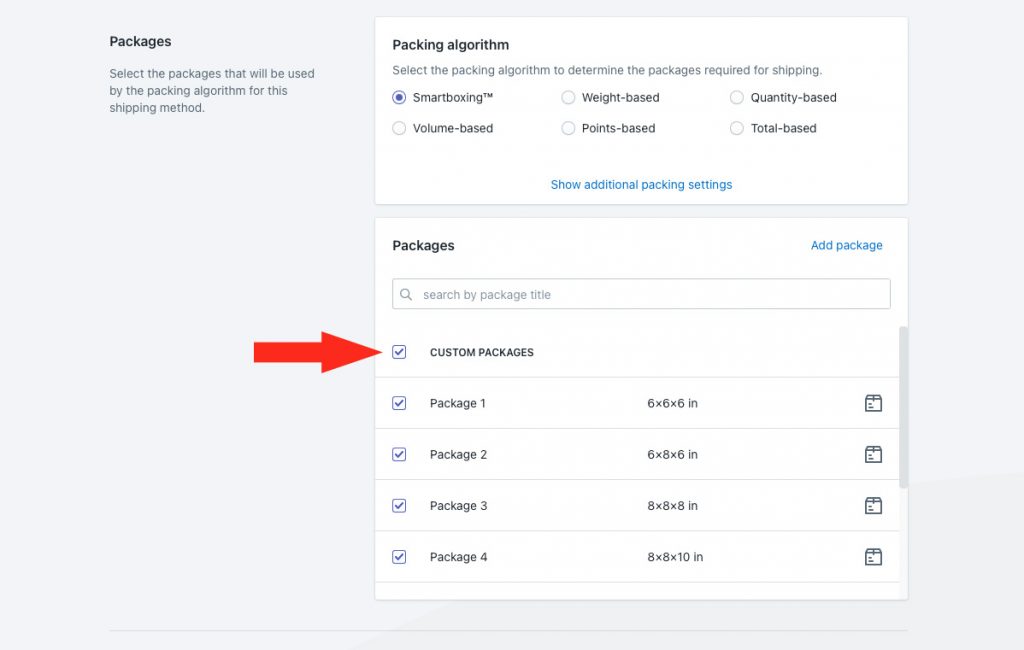
Or, select specific packages. If you have a lot of packages, use the search function or scroll through the list.
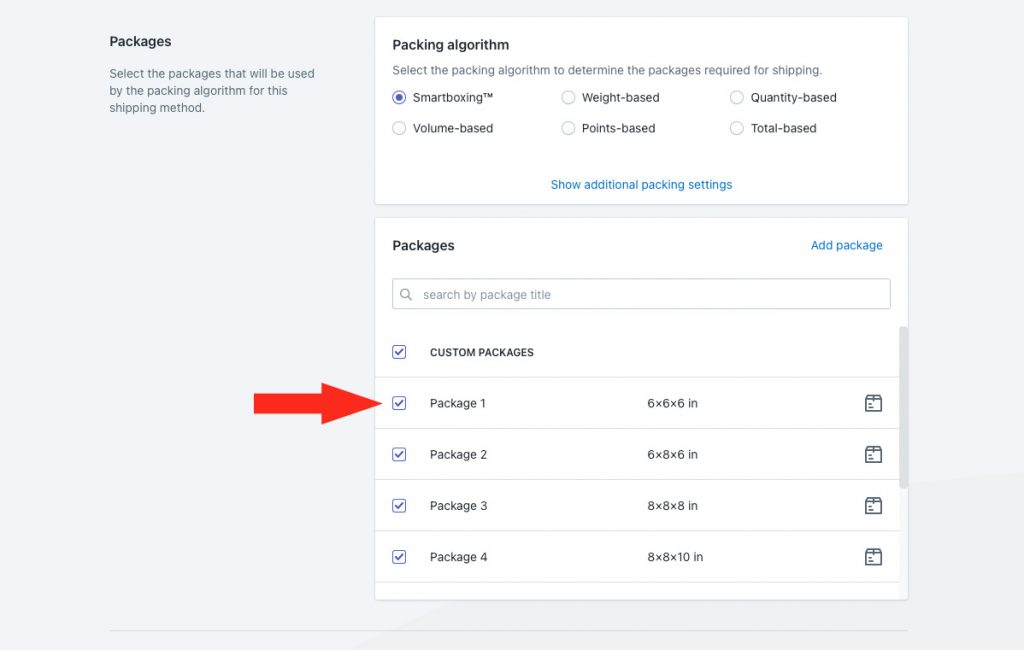
Packages not selected will be ignored by the shipping method.
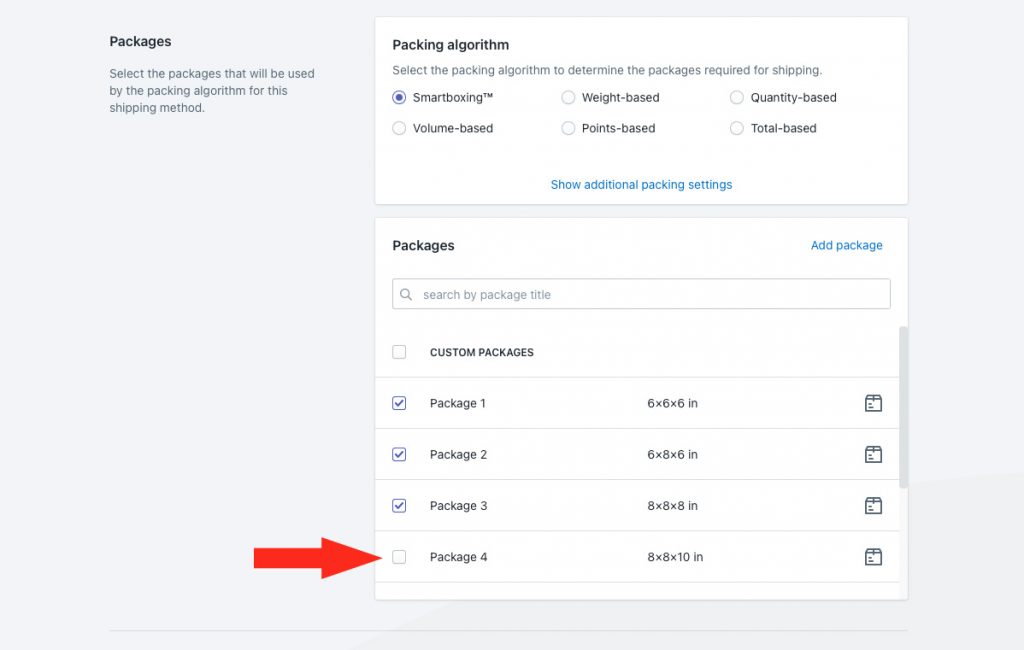
Packages that have been turned off in your central package settings are muted. They cannot be selected or deselected, and will be ignored by the shipping method, regardless of their check box setting.
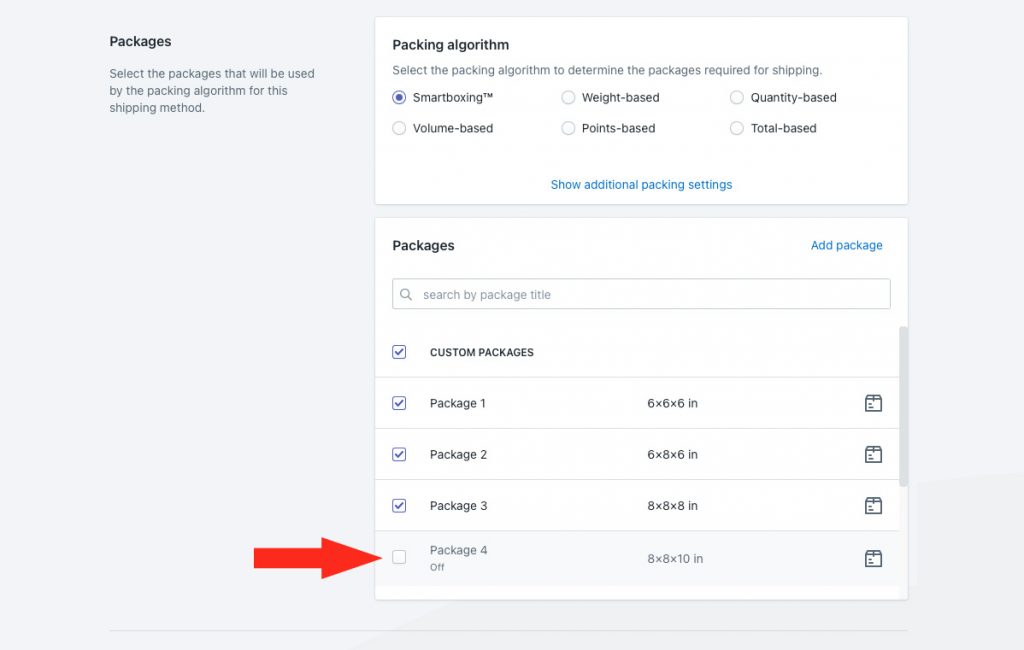
To change the On/Off status of a package, go to your central package settings after saving your shipping method.
Shipping Origin
Real-time carrier rates can be calculated using the primary location set up in your eCommerce platform or a custom location. This is useful if you ship products from different warehouse locations.
1) Select the ship from location.
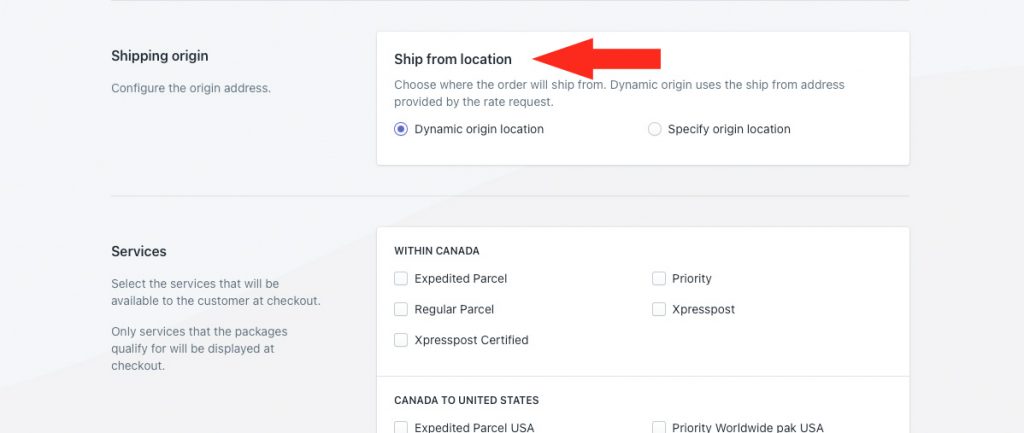
You have two (2) settings to choose from:
Dynamic origin location – live carrier rates will be calculated based on the distance between the customer’s address and your primary eCommerce platform address. This is the default setting.
Specify origin location – live carrier rates will be calculated based on the address specified in Step 2.
If you selected dynamic, skip ahead to Services.
All of the custom locations saved to your main Locations settings will be listed under Locations as selectable options. Or, you can add a location directly from the shipping method.
If the custom shipping origin you want to assign to the shipping method is listed, skip ahead to Step 6. Or, to add a location, continue to Step 2.
2) Click Add location.
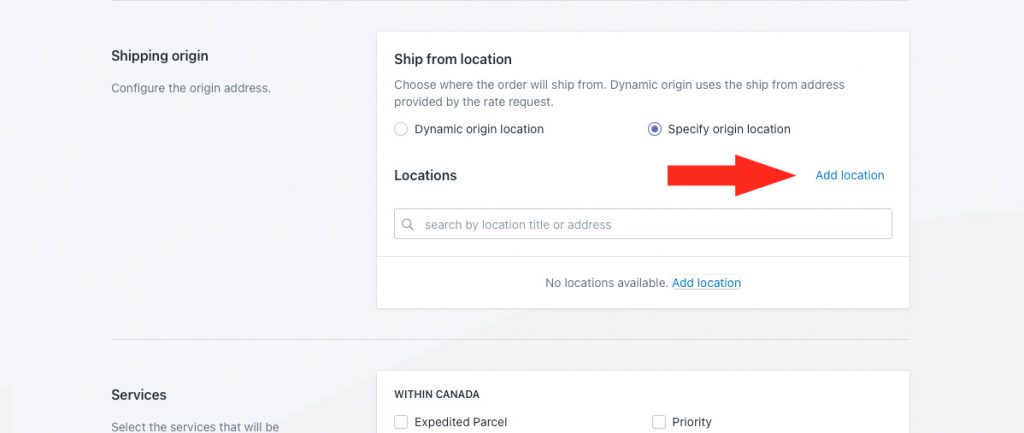
3) Enter a location title, such as ‘Warehouse 2’.
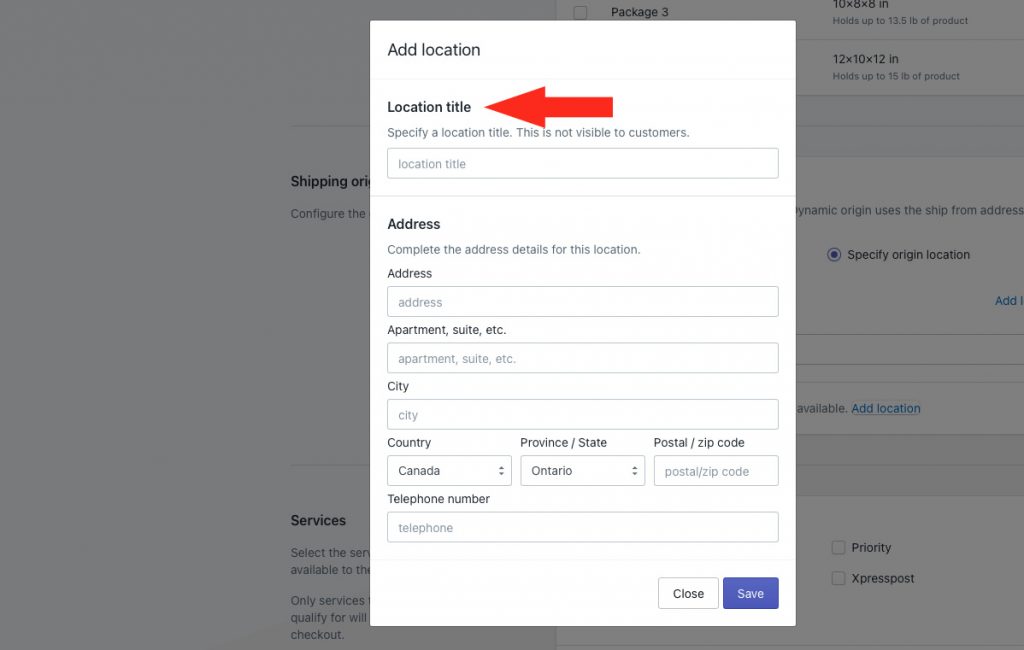
4) Enter the address for your custom ship from location.
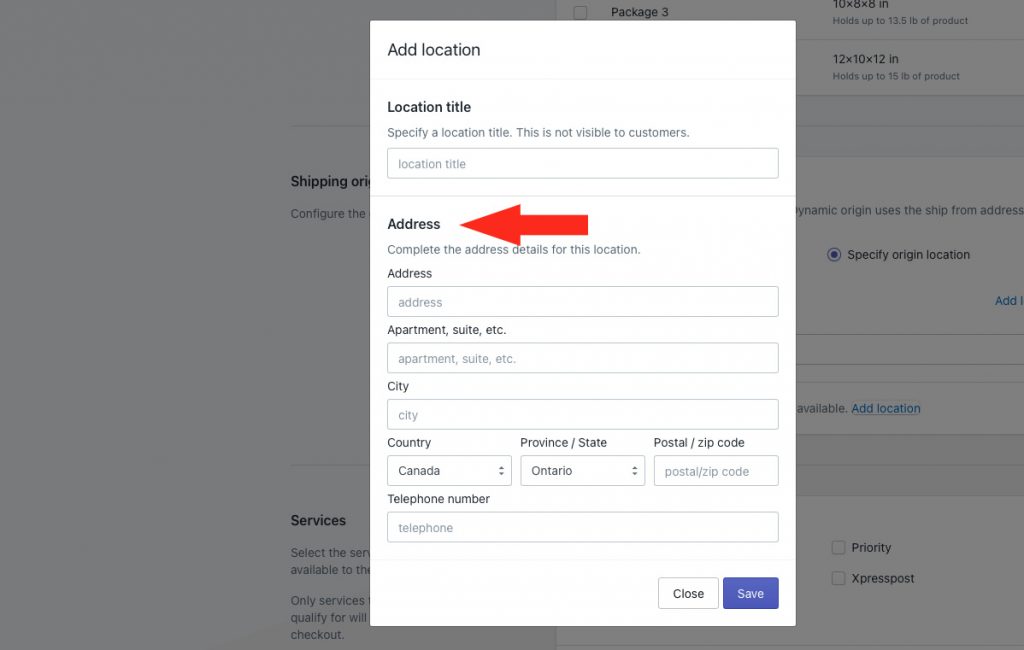
That means you don’t have to fill in every field, such as the postal/zip code field. Some carriers require a complete address in order to accurately calculate live rates.
5) Click the Save button.
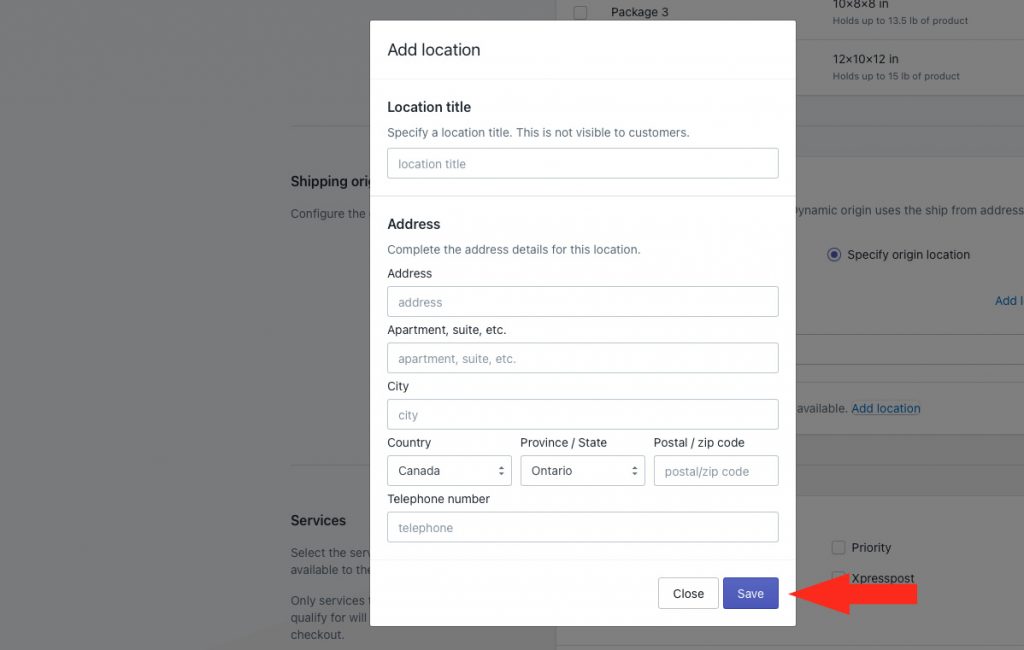
6) Select a location. This location will be used as the starting point for live carrier rate calculations in this shipping method.
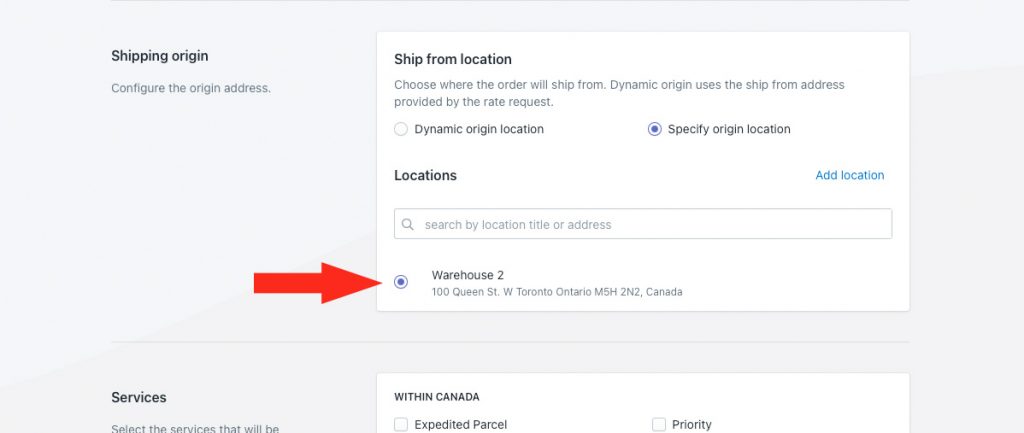
Services
Carriers typically offer multiple delivery services, both domestically and internationally. Most services offered by our integrated carrier partners are supported by Intuitive Shipping. If a carrier delivery service is not listed as an option in your shipping method, please contact us to let us know.
1) Select all of services you wish to offer to your customers.
If this shipping method was assigned to a domestic zone, be sure to select domestic services. If this shipping method was assigned to an international zone, be sure to select international services.
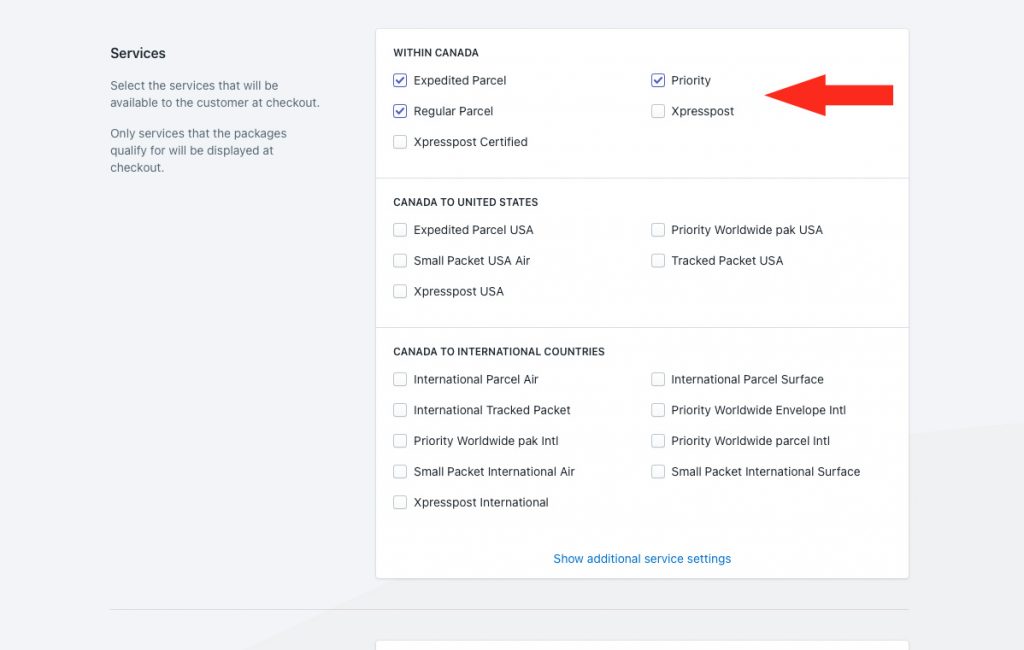
Let’s say you’ve selected Canada Post Expedited Parcel, Regular Parcel and Priority. If a customer lives in a postal code where Priority is not offered by Canada Post, they will only see Expedited and Regular services at checkout.
By default, all selected services are displayed at checkout, if available in the customer’s area. Each parcel service can be filtered so that only one service is displayed, depending on your preference.
If you want all of the selected services, if available, to appear at checkout, skip ahead to Account. If you want to manage which services are displayed, continue to Step 2.
2) Click Show additional service settings.
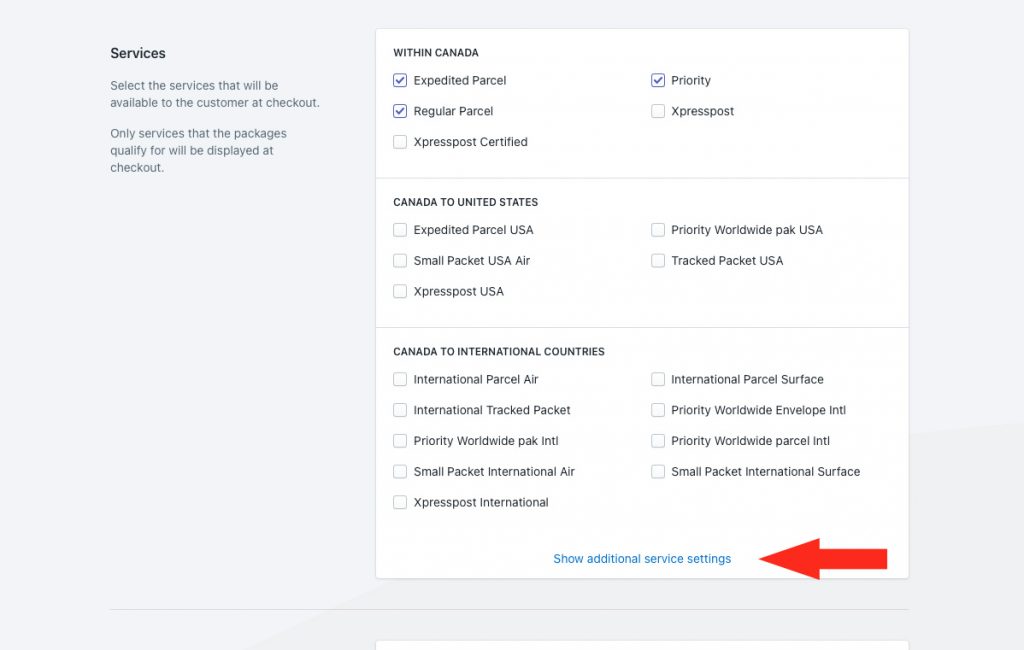
3) Choose how services will be filtered.
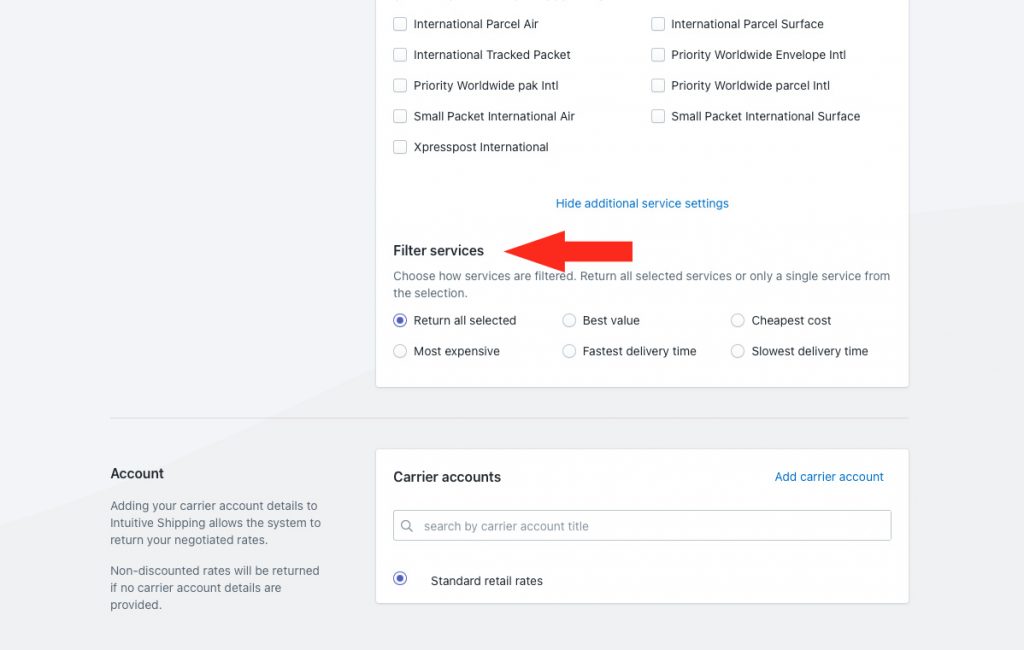
You have six (6) options to choose from:
Return all selected – all available services selected in Step 1 will be displayed to the customer at checkout.
Best value – from the services selected in Step 1, only the available service with the best value will be displayed to the customer at checkout.
Cheapest cost – from the services selected in Step 1, only the available service with the lowest cost will be displayed to the customer at checkout.
Most expensive – from the services selected in Step 1, only the available service with the highest cost will be displayed to the customer at checkout.
Fastest delivery time – from the services selected in Step 1, only the available service with the fastest estimated delivery time will be displayed to the customer at checkout.
Slowest delivery time – from the services selected in Step 1, only the available service with the slowest estimated delivery time will be displayed to the customer at checkout.
Account
If you have an account with the carrier you selected at the beginning of this guide, you can use that account to access your discounted or negotiated rates. If you previously connected your preferred carrier account with Intuitive Shipping, it will be listed below Carrier accounts as a selectable option.
Most carriers offer retail rates which can be used if you don’t have an account with the carrier. These are rates available to the general public without the need for a carrier account. If the carrier you selected at the beginning of this guide offers retail rates, a ‘Standard retail rates’ option will be displayed below Carrier accounts and selected as the default option. If the carrier does not offer retail rates, nothing will be displayed.
To use the standard retail rates option (if available) or if the carrier account you want to assign to the shipping method is available and listed, skip ahead to Step 5. To add a new carrier account, continue to Step 1.
1) Click Add a carrier account.
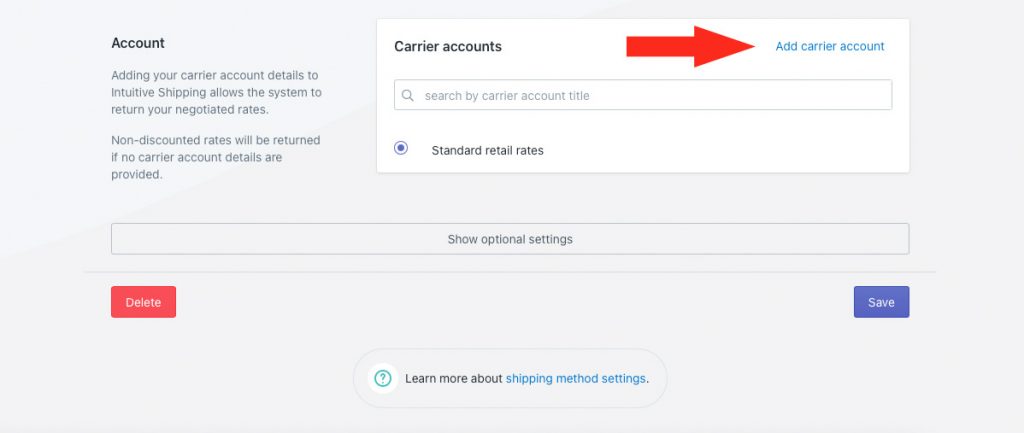
2) Enter a carrier account title.
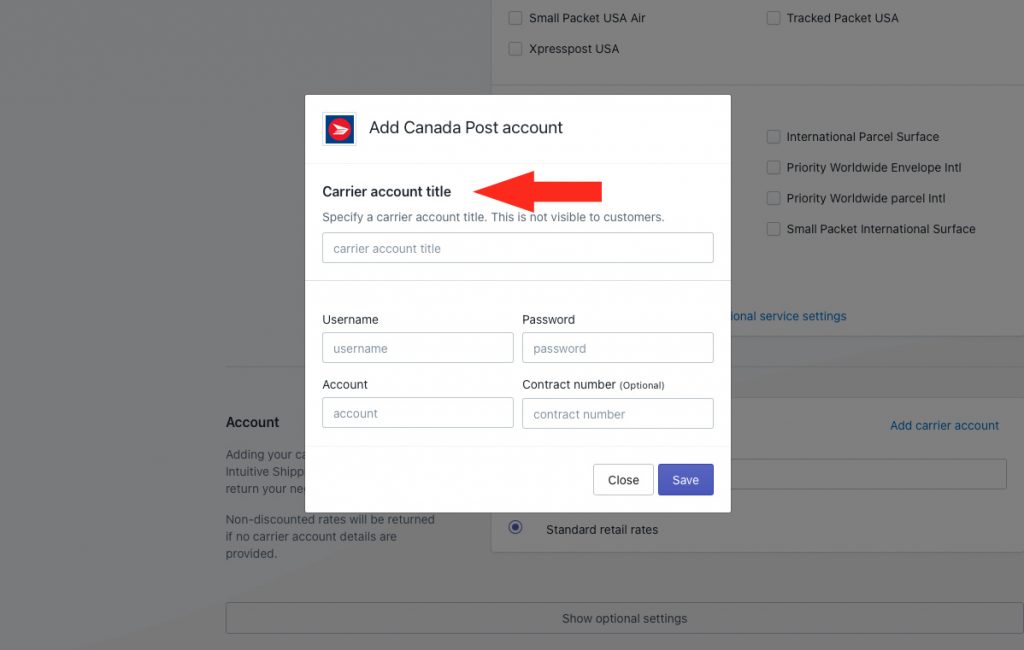
3) Enter your account credentials. Credential requirements vary by carrier.
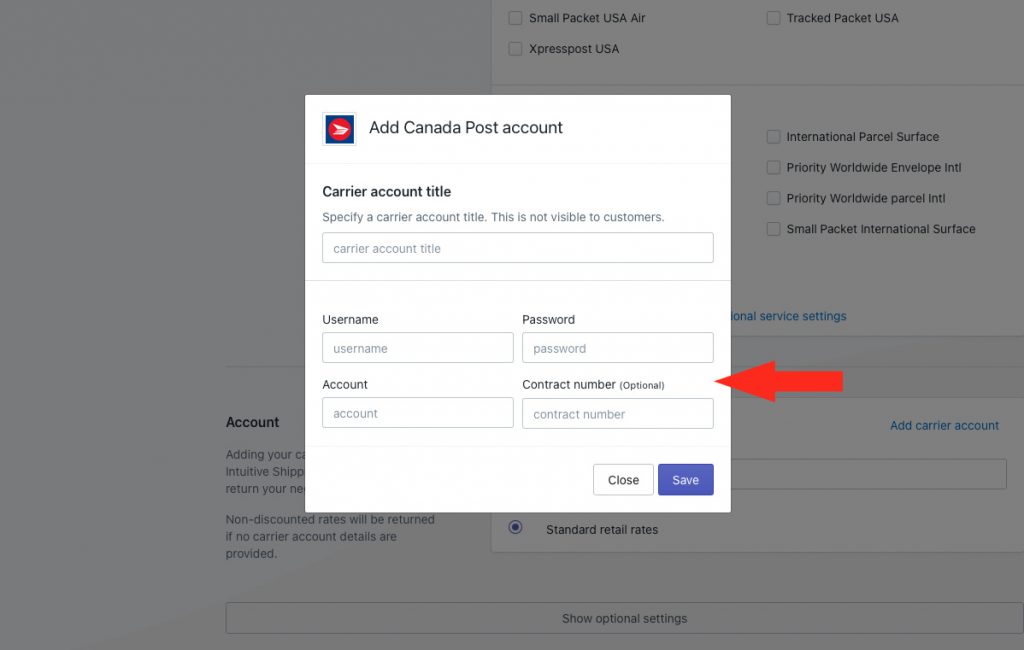
4) Click the Save button.
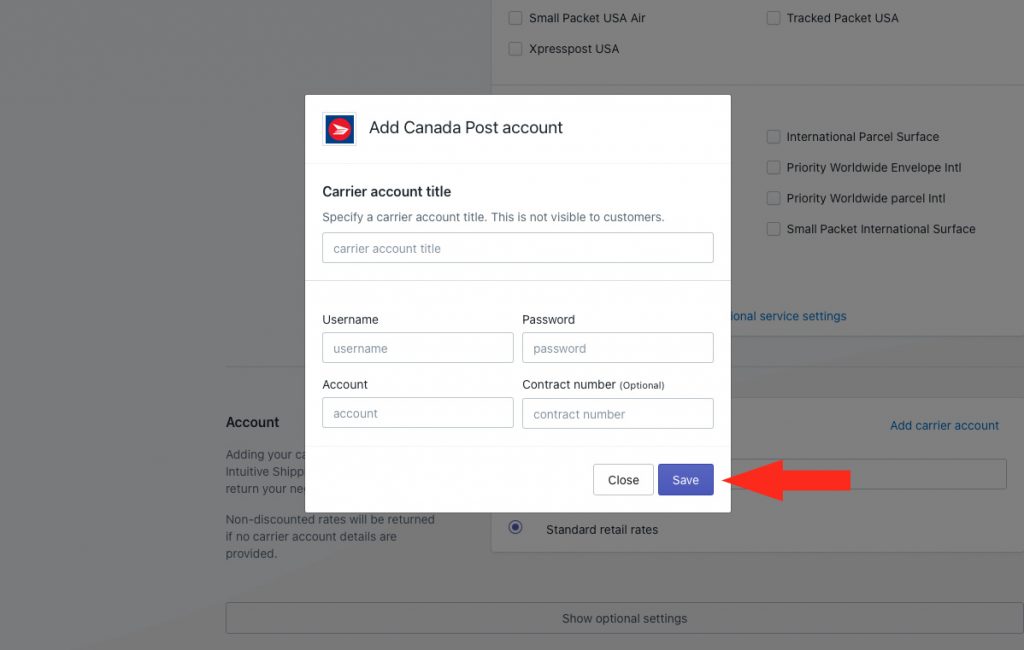
5) Select a carrier account or use standard retail rates, if available.
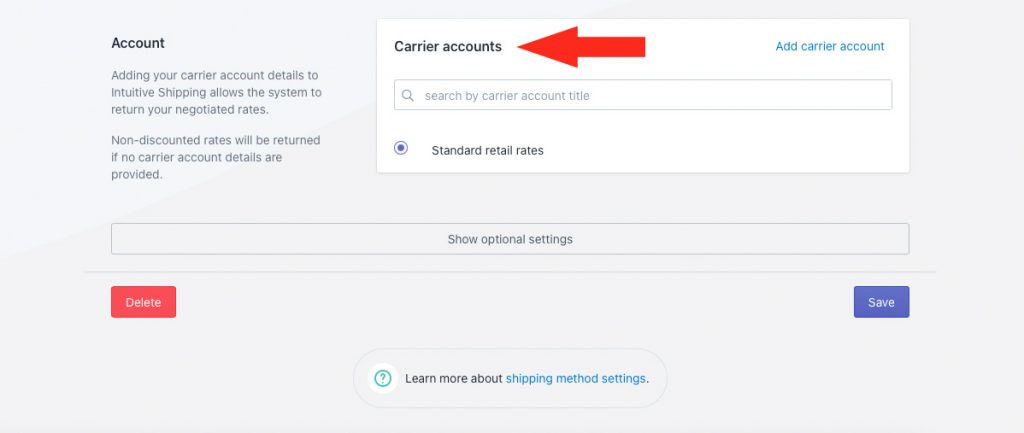
6) If desired, click Show optional settings, then continue to the next section.
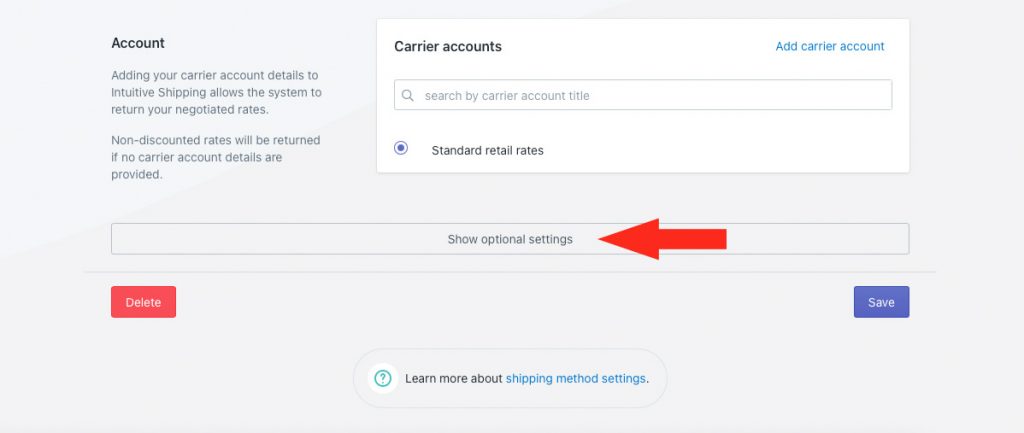
Optional Settings
Carrier settings, as well as other settings for fallback rates, cost adjustments, free shipping, custom shipping blending and rate blending give you further control of how shipping is calculated at checkout. If you don’t need to adjust these settings, skip ahead to Save Your Settings. Otherwise, continue to Carrier Settings.
These settings are not required.
Carrier Settings
Some carriers have additional settings that can be customized. For example, FedEx lets you choose destination address type, package insurance, pickup method, packaging type and whether or not you want to use FedEx One Rate. Whereas, USPS lets you choose between retail or discounted rates.
Each carrier has different optional settings, and some carriers, like Canada Post, don’t have any optional carrier settings.
1) Adjust the carrier settings as needed, and if available.
Carrier Service Fallback Rate
1) Choose if you want a fallback rate to appear at checkout in situations when the carrier service times out. This is useful when the carrier’s servers are down or when they’re overwhelmed during peak periods like Black Friday.
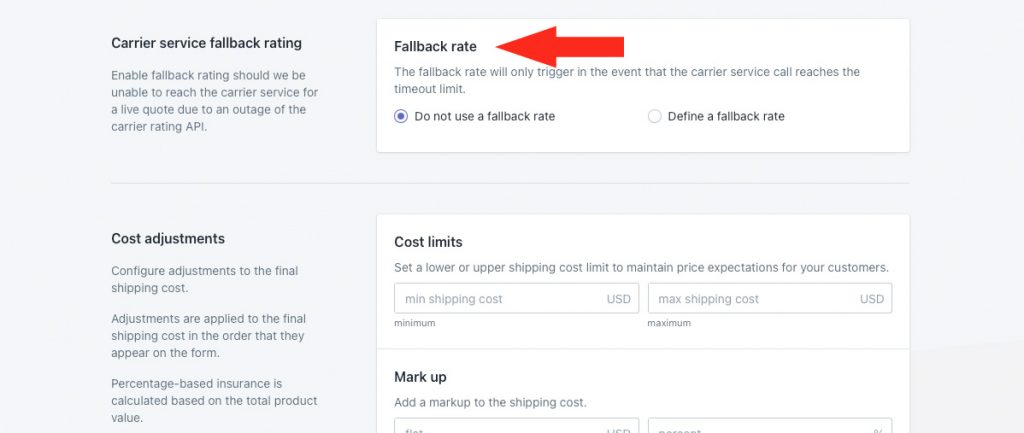
You have two (2) settings to choose from:
Do not use a fallback rate – when carrier service calls time out, no shipping rates from this shipping method are displayed at checkout. This is the default setting.
If you select this option, skip ahead to Cost Adjustments.
Define a fallback rate – when carrier service calls time out, the fallback rate entered in Step 2 is displayed at checkout, along with any fallback rate display settings entered in Steps 4 to 7.
That means the fallback rate will not be displayed for reasons such as: an over-sized package or shipment, an invalid address, missing or invalid carrier credentials, missing weights or dimensions, etc.
Fallback rates only activate when the system times out waiting for a carrier response.
2) If you selected Define a fallback rate in Step 1, enter a fallback shipping cost.
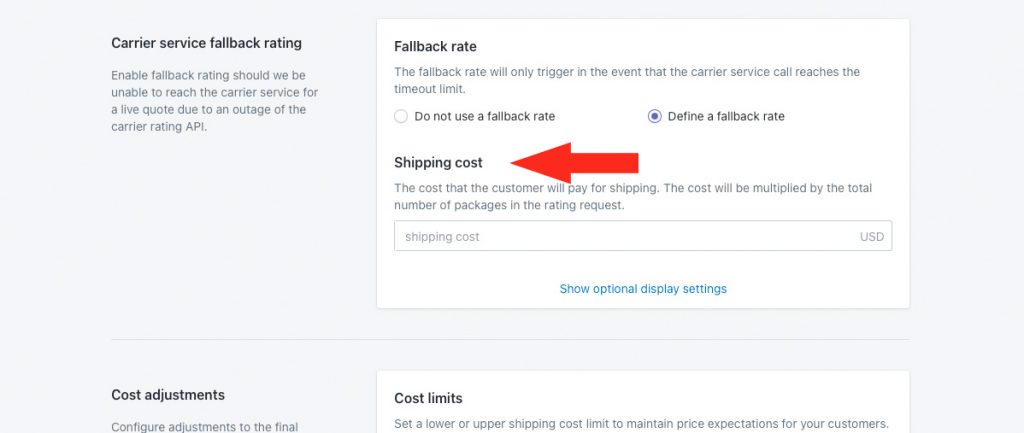
Let’s say you’ve set up a fallback rate of $15.00, and a customer order results in three (3) packages being required based on the packing algorithm. If the carrier rates time out and the fallback rate is activated, the customer will be charged $45.00 for shipping at checkout ($15.00 x 3 packages).
Additional settings are available for fallback rate titles, descriptions, delivery times and service codes. In the event the fallback rate is activated, these settings will override the main shipping method settings configured in the General section of this guide.
3) Click Show optional display settings.
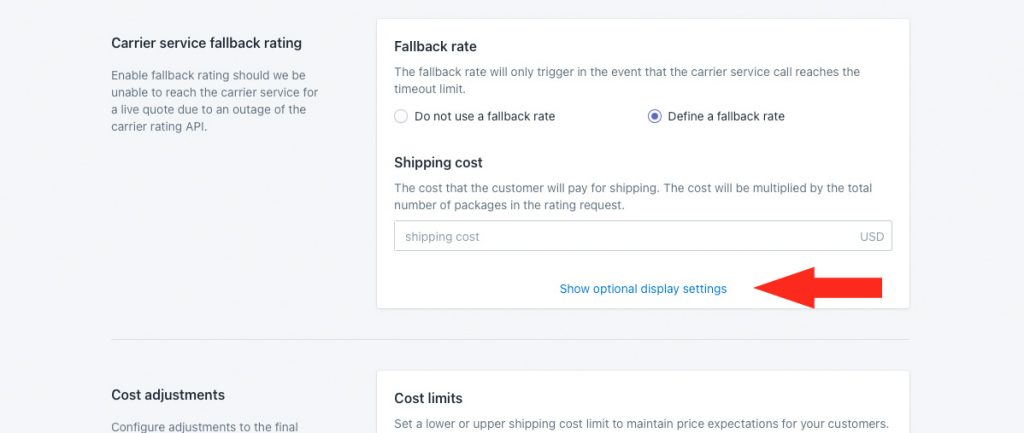
4) If desired, enter a fallback rate title, such as ‘Shipping’ or the carrier’s name. When the fallback rate is activated, this title will replace either the carrier service title (or titles) or the shipping method title, depending on the setting you selected in General Step 2.
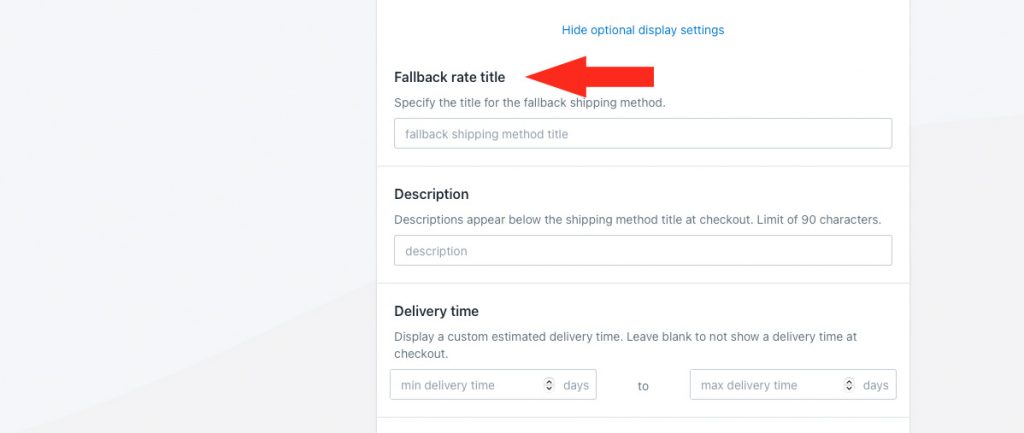
5) If desired, enter a fallback rate description. When the fallback rate is activated, this description will replace the description (if any) entered in General Step 4.
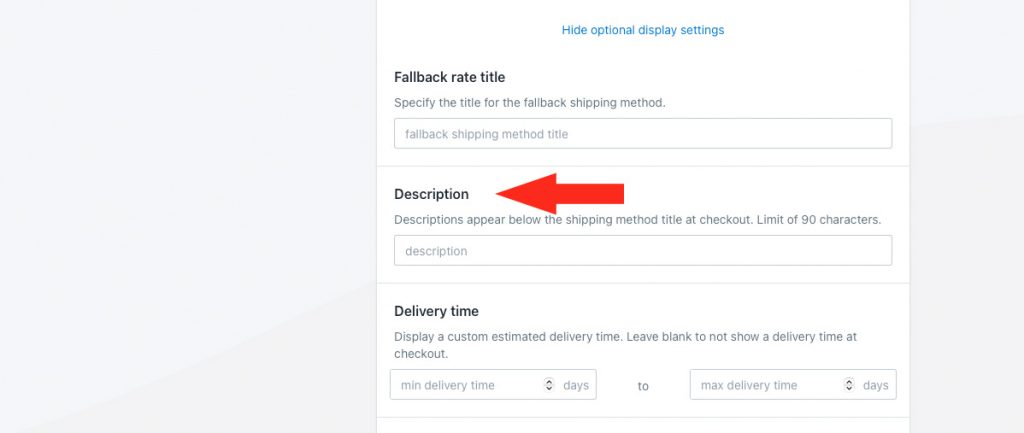
6) If desired, enter a fallback rate delivery time. For fallback rates, consider using a range that covers your average to longest carrier delivery times. When the fallback rate is activated, this delivery time will replace either the carrier delivery time or your custom delivery time, depending your settings in General Steps 6 through 9.
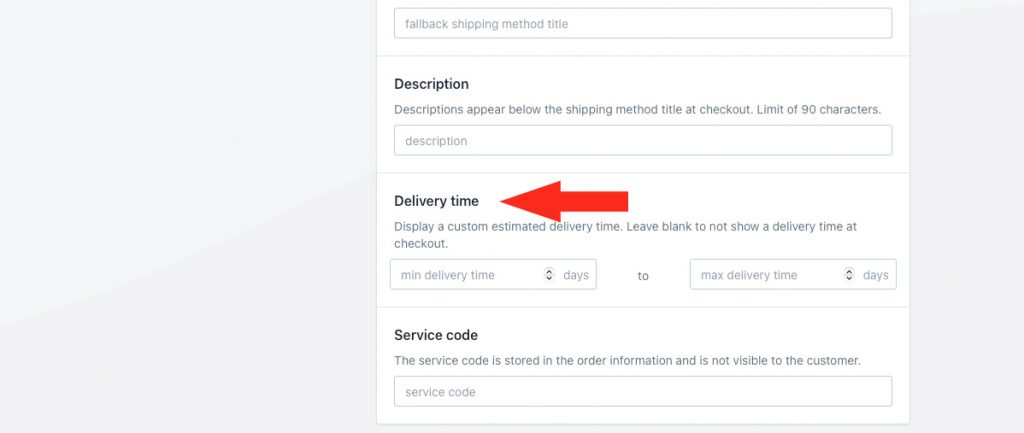
Min delivery time – enter the lower limit of your delivery time range.
Max delivery time – enter the upper limit of your delivery range. When combined with the min setting, delivery times will be displayed like ‘3 to 5 business days’ at checkout.
For example, if you prefer to have delivery time displayed as ‘3 business days’ instead of ‘3 to 5 business days’, enter ‘3’ in either minimum or maximum and leave the other field blank.
7) If desired, enter a fallback rate service code, such as ‘FALLBACK’. The service code is pushed to your fulfillment service (if applicable) when a customer successfully completes their checkout. When the fallback rate is activated, this service code will replace either the carrier service code or the service code entered in General Step 10.
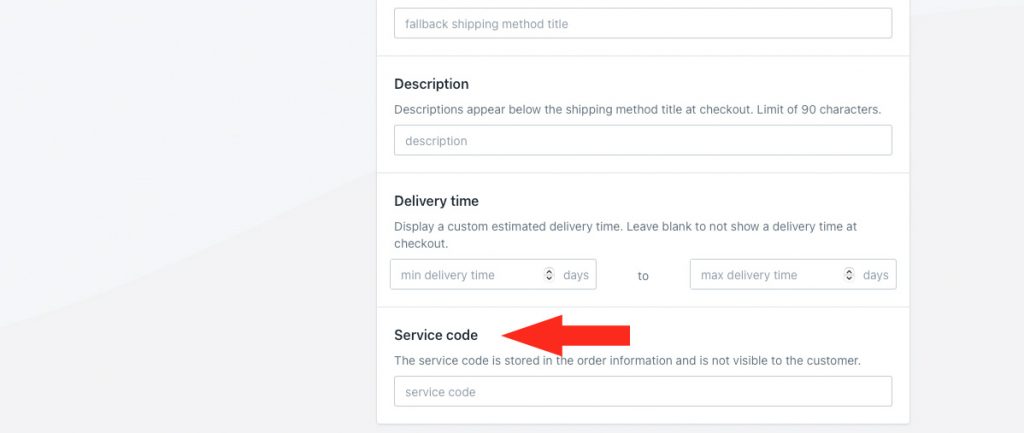
Cost Adjustments
Take full control of how parcel service shipping costs will be presented at checkout by applying final adjustments to the live rate calculation.
Cost adjustments are applied in the order they are listed in the app: cost limits first, then shipping credits, then mark ups, then handling, then insurance, then discounts, and finally, rounding.
1) If desired, add cost limits.
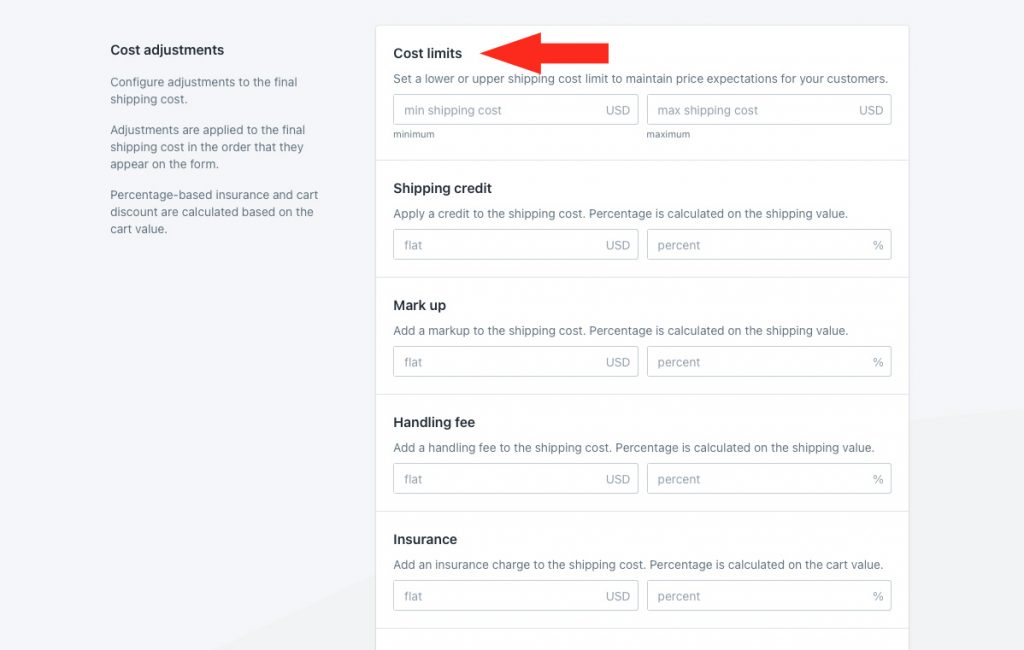
You have two (2) settings to choose from:
Min shipping cost – if the shipping cost returned by the carrier is less than this value, it will be adjusted up to the minimum cost.
Max shipping cost – if the shipping cost returned by the carrier is more than this value, it will be adjusted down to the maximum cost.
2) If desired, apply a shipping credit.
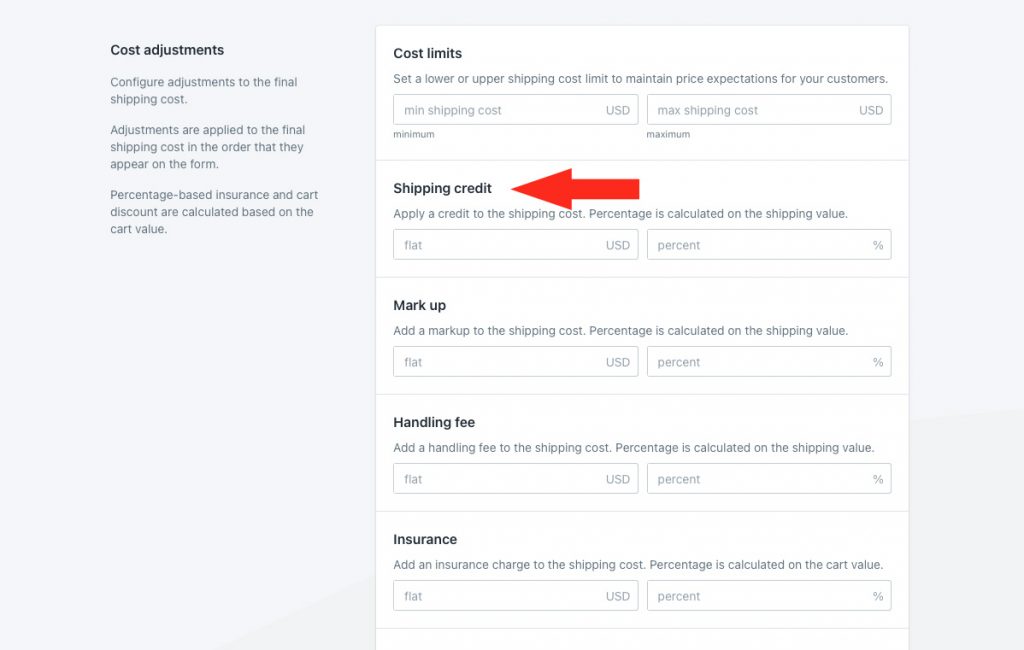
You have two (2) settings to choose from:
Flat – this amount will be subtracted from the shipping cost after any cost limit adjustments.
Percentage – this percentage of the shipping cost, after any cost limit adjustments, will be subtracted from the adjusted shipping cost.
3) If desired, add a mark up.
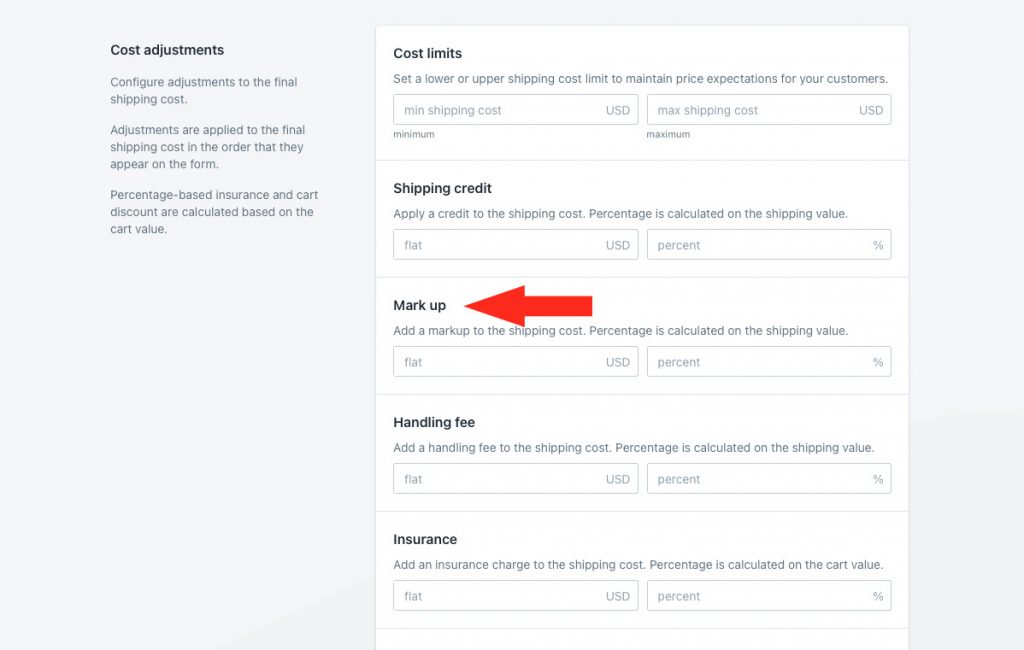
You have two (2) settings to choose from:
Flat – this amount will be added to the shipping cost after any cost limit adjustments and shipping credits.
Percentage – this percentage of the shipping cost, after any cost limit adjustments and shipping credits, will be added to the adjusted shipping cost.
4) If desired, add a handling fee.
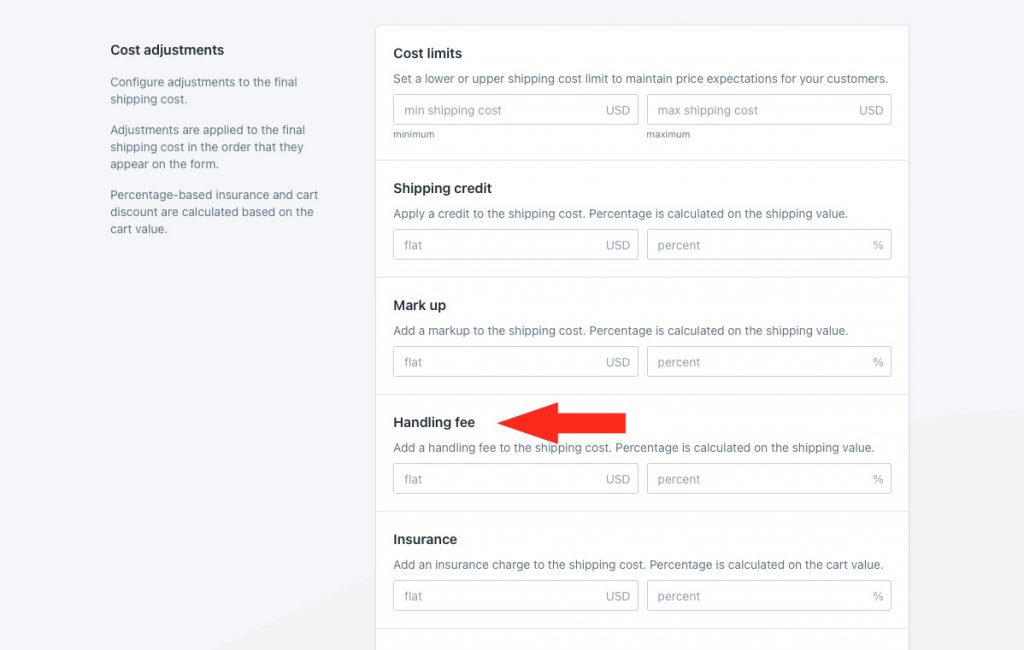
You have two (2) settings to choose from:
Flat – this amount will be added to the shipping cost after any cost limit adjustments, shipping credits and mark ups.
Percentage – this percentage of the shipping cost – after any cost limit adjustments, shipping credits and mark ups – will be added to the adjusted shipping cost.
5) If desired, add insurance.
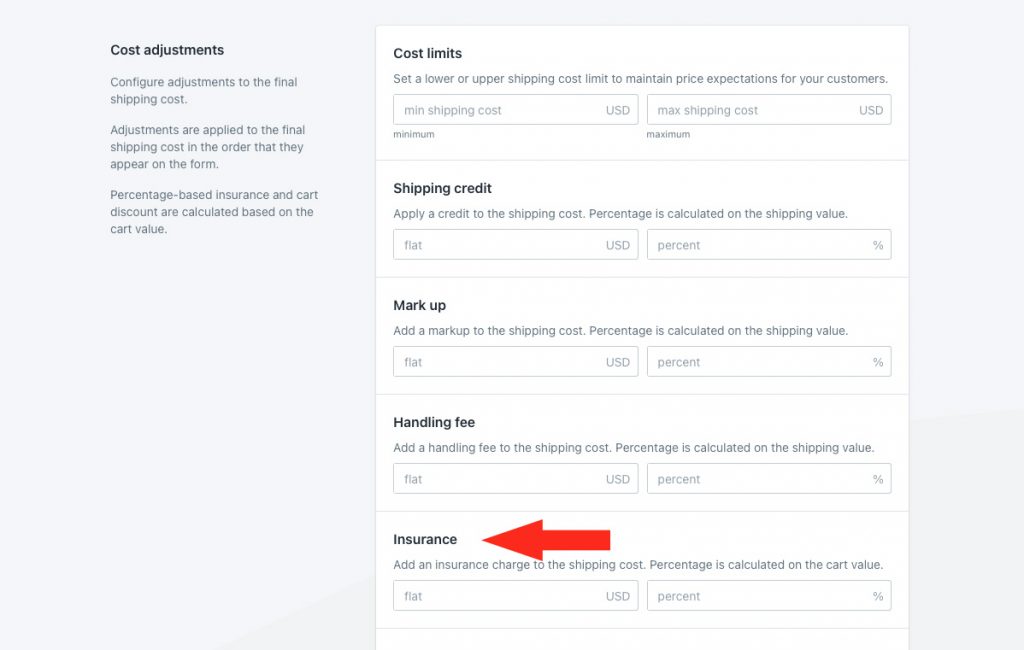
You have two (2) settings to choose from:
Flat – this amount will be added to the shipping cost after any cost limit adjustments, shipping credits, mark ups and handling fees.
Percentage – this percentage of the total cart value will be added to the adjusted shipping cost.
6) If desired, add a discount.
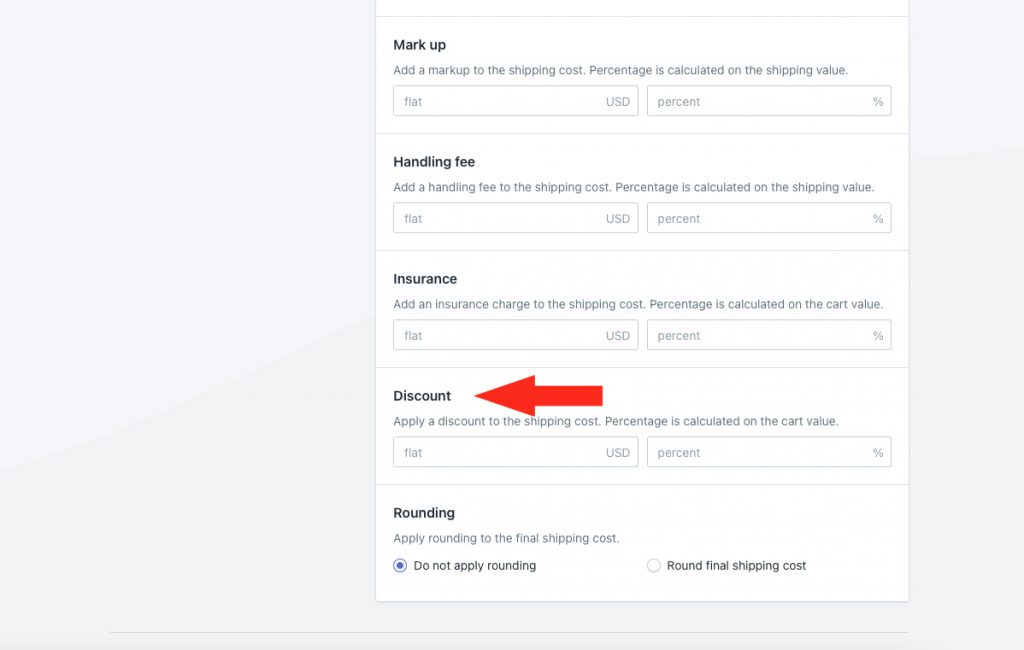
You have two (2) settings to choose from:
Flat – this amount will be subtracted from the shipping cost after any cost limit adjustments, shipping credits, mark ups, handling fees and insurance.
Percentage – this percentage of the total cart value will be subtracted from the adjusted shipping cost.
7) If desired, apply rounding.
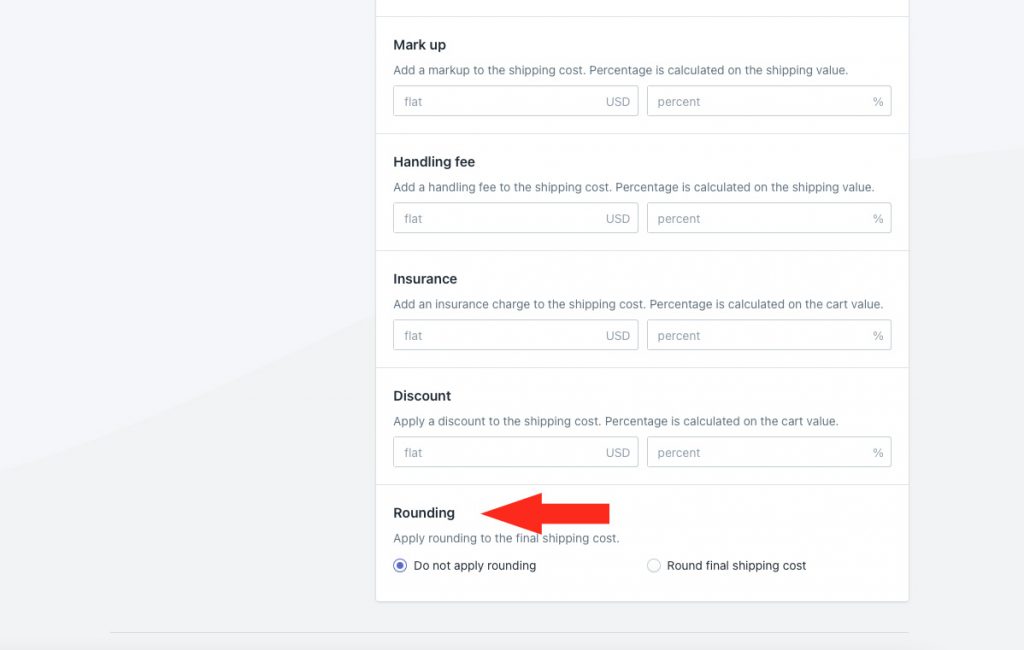
You have two (2) settings to choose from:
Do not apply rounding – the final shipping cost, after all other cost adjustments, will be displayed exactly as calculated.
Round final shipping cost – the final shipping cost, after all other cost adjustments, will be rounded up or down, depending on the settings selected in Steps 8 and 9.
8) Choose which direction to round the shipping cost.
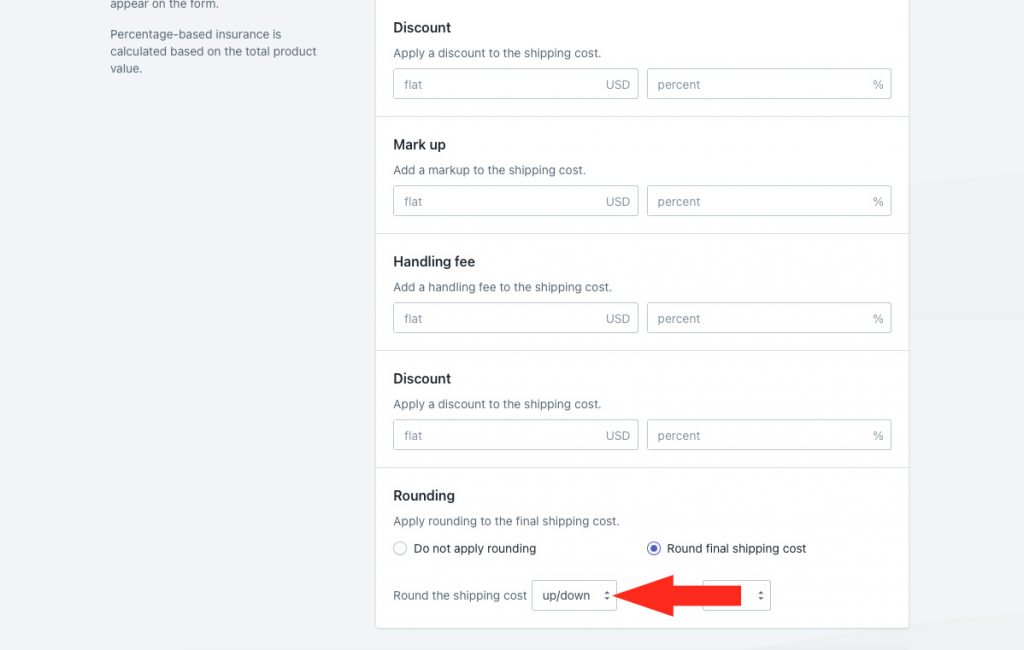
You have three (3) settings to choose from:
Up/down – the final adjusted shipping cost will be rounded either up or down by the increment selected in Step 9 – whichever is closer.
Up – the final adjusted shipping cost will be rounded up by the increment selected in Step 9.
Down – the final adjusted shipping cost will be rounded down by the increment selected in Step 9.
9) Choose the amount to round the shipping cost.
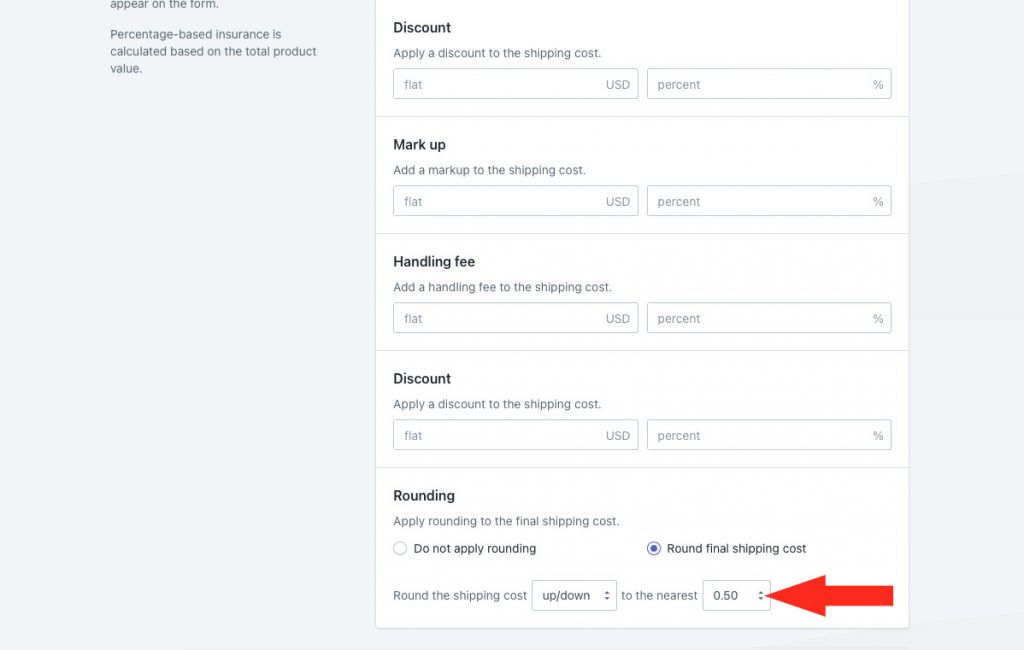
You have four (4) settings to choose from:
0.50 – the final shipping cost will be rounded up or down to the nearest 0.50 of your base currency. If the final shipping cost is $18.80, the rounded cost will be either $18.50 or $19.00, depending on the setting selected in Step 8.
1.00 – the final shipping cost will be rounded up or down to the nearest 1.00 of your base currency. If the final shipping cost is $18.80, the rounded cost will be either $18.00 or $19.00, depending on the setting selected in Step 8.
5.00 – the final shipping cost will be rounded up or down to the nearest 5.00 of your base currency. If the final shipping cost is $18.80, the rounded cost will be either $15.00 or $20.00, depending on the setting selected in Step 8.
10.00 – the final shipping cost will be rounded up or down to the nearest 10.00 of your base currency. If the final shipping cost is $18.80, the rounded cost will be either $10.00 or $20.00, depending on the setting selected in Step 8.
Free Shipping
Activate free shipping when the customer’s cart exceeds a threshold limit. This is useful if you want to offer free shipping over a certain cart amount or only under a certain weight limit.
If you don’t need a free shipping threshold, skip ahead to Custom Shipping Blending. Otherwise, continue to Step 1.
1) If desired, select Set a free shipping threshold.
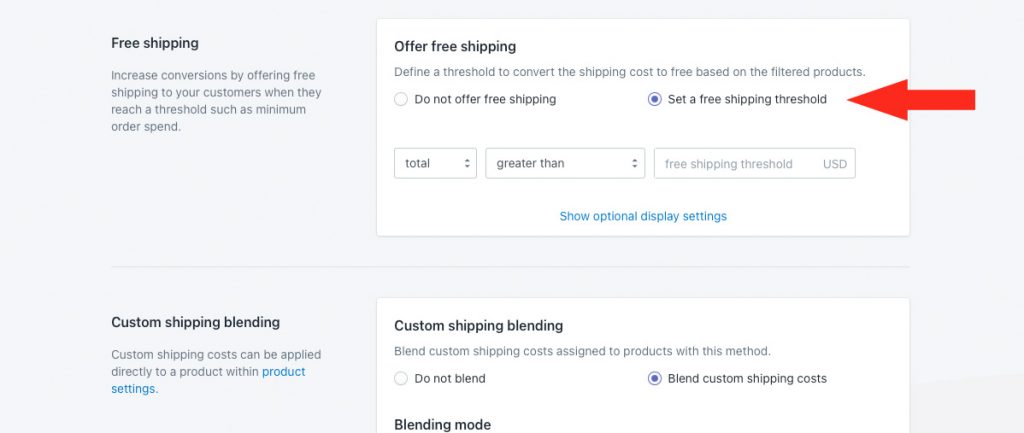
2) Select a cart value type.
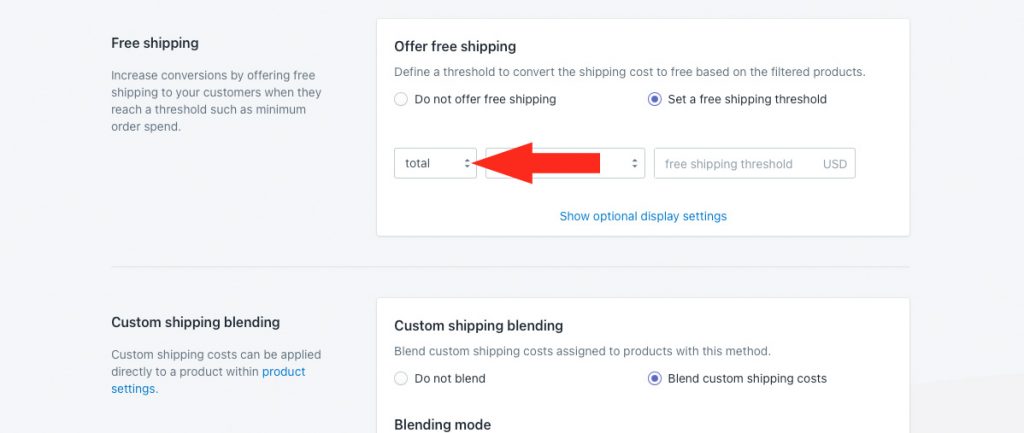
You have three (3) settings to choose from:
Total – free shipping will activate based on the total value of items in the cart.
Quantity – free shipping will activate based on the total number of items in the cart.
Weight – free shipping will activate based on the total weight of items in the cart.
3) Select the logic.
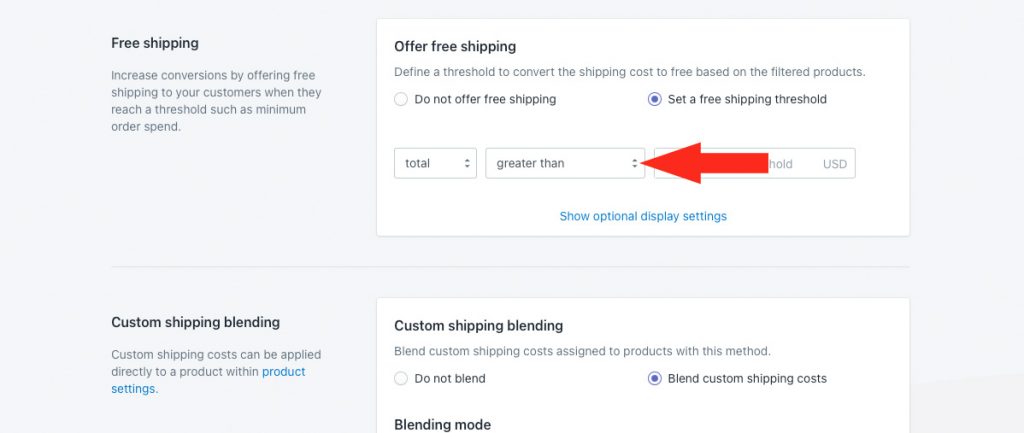
You have six (6) settings to choose from:
Greater than – free shipping will activate when the actual cart value is more than the value entered in Step 4.
Greater than or equals – free shipping will activate when the actual cart value is equal to or more than the value entered in Step 4.
Less than – free shipping will activate when the actual cart value is less than the value entered in Step 4.
Less than or equals – free shipping will activate when the actual cart value is equal to or less than the value entered in Step 4.
Equals – free shipping will activate when the actual cart value is exactly the same as the value entered in Step 4.
Does not equal – free shipping will activate when the actual cart value is anything but the value entered in Step 4.
4) Enter the threshold value. Free shipping will activate when this threshold is met, depending on the settings selected in Steps 2 and 3.
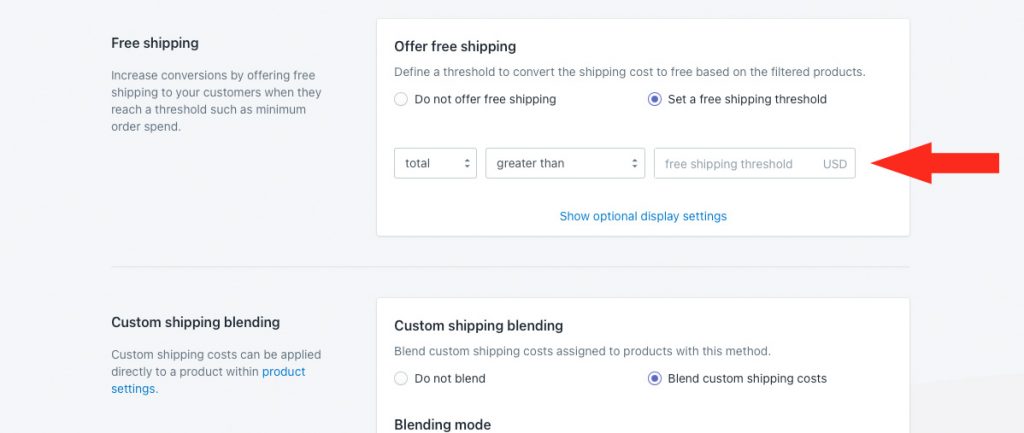
Additional free shipping settings are available for a title, description, delivery time and service code when the free shipping threshold is met. This is useful if you want to override the parcel service settings when free shipping is activated.
If you don’t need a custom title, description, delivery time or service code for free shipping, skip ahead to Custom Shipping Blending. Otherwise, continue to Step 5.
5) Click Show optional display settings.
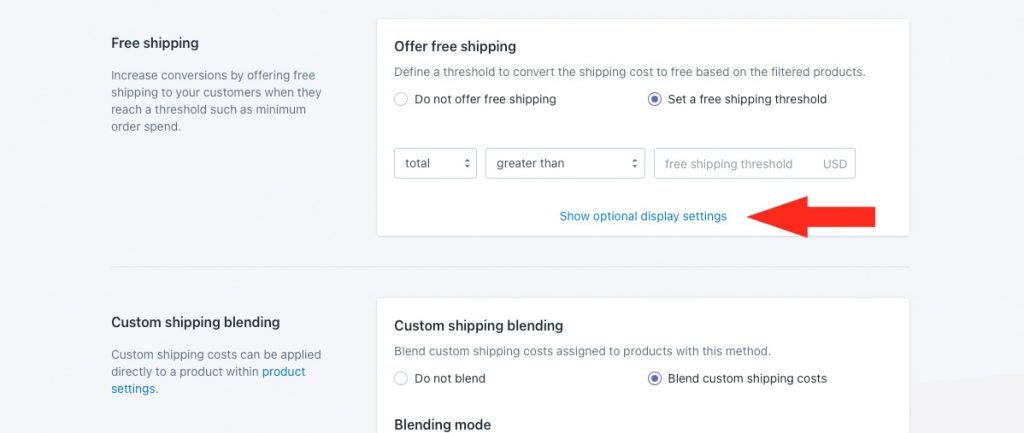
6) If desired, enter a free shipping title. The free shipping title will override the main title, regardless of which title option you selected in General Step 2, when the free shipping threshold is reached.
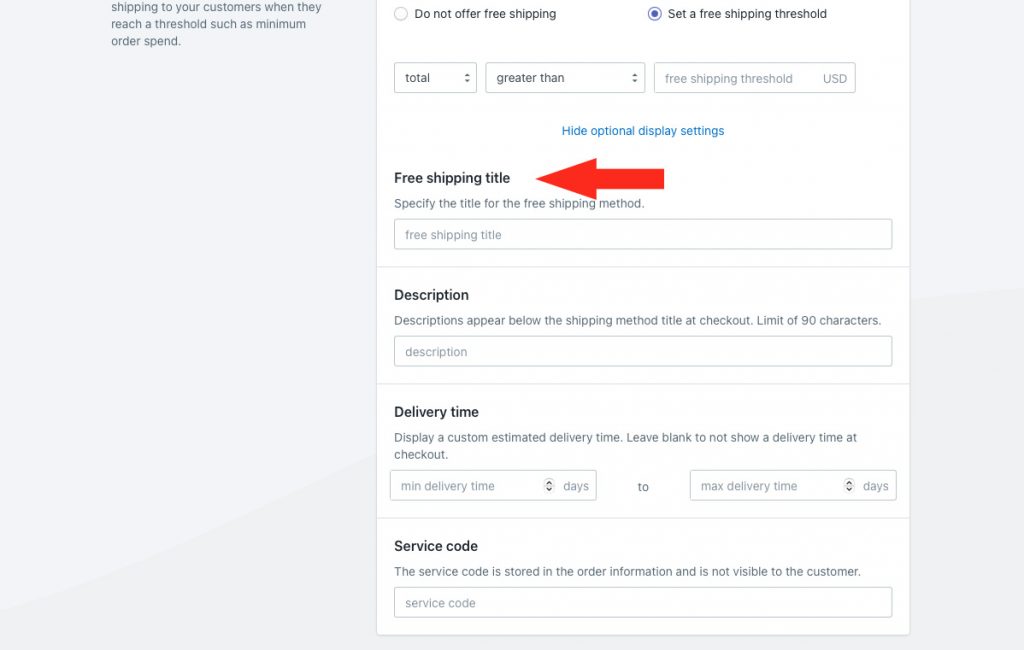
7) If desired, enter a free shipping description. The free shipping description will override the main description from General Step 4 when the free shipping threshold is reached.
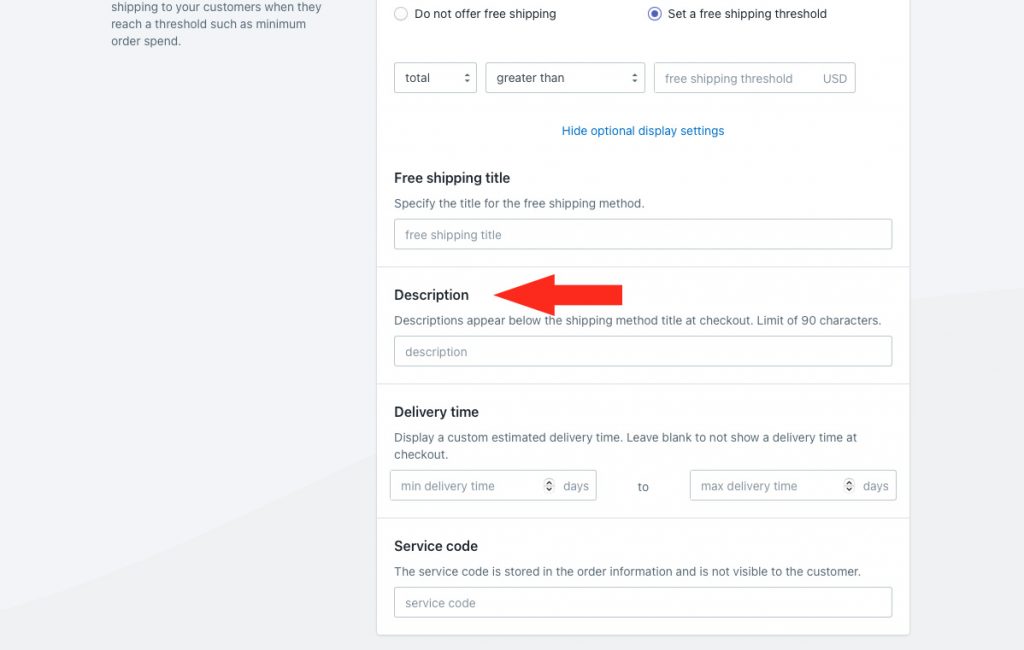
8) If desired, enter a free shipping delivery time. The free shipping title will override the delivery time, regardless of the delivery time settings from General Steps 6 to 9, when the free shipping threshold is reached.
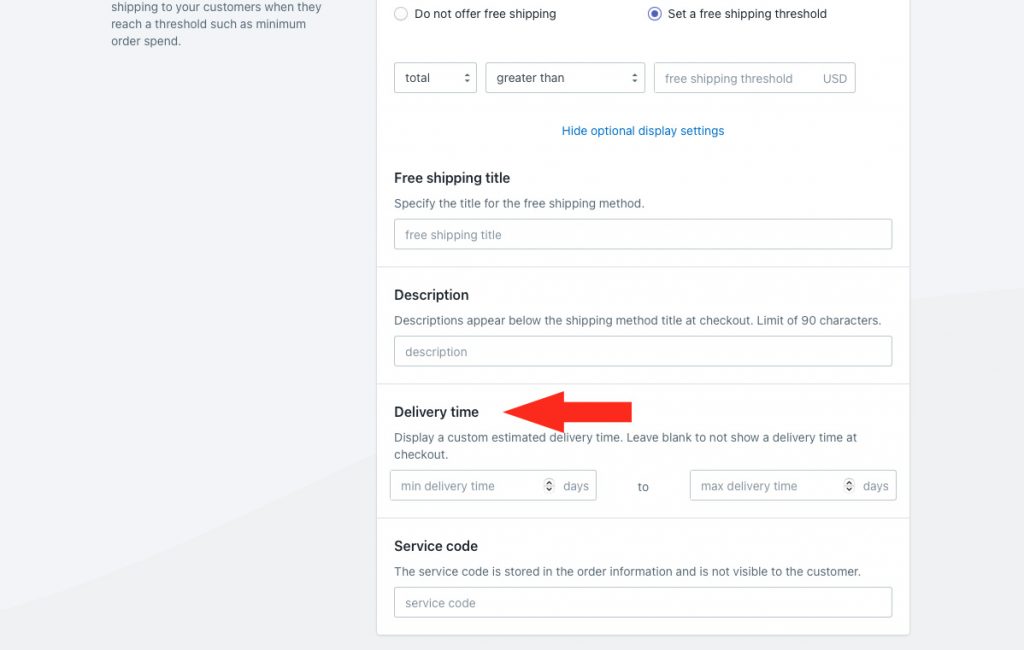
9) If desired, enter a free shipping service code. The free shipping service code will override the service code from General Step 10, when the free shipping threshold is reached.
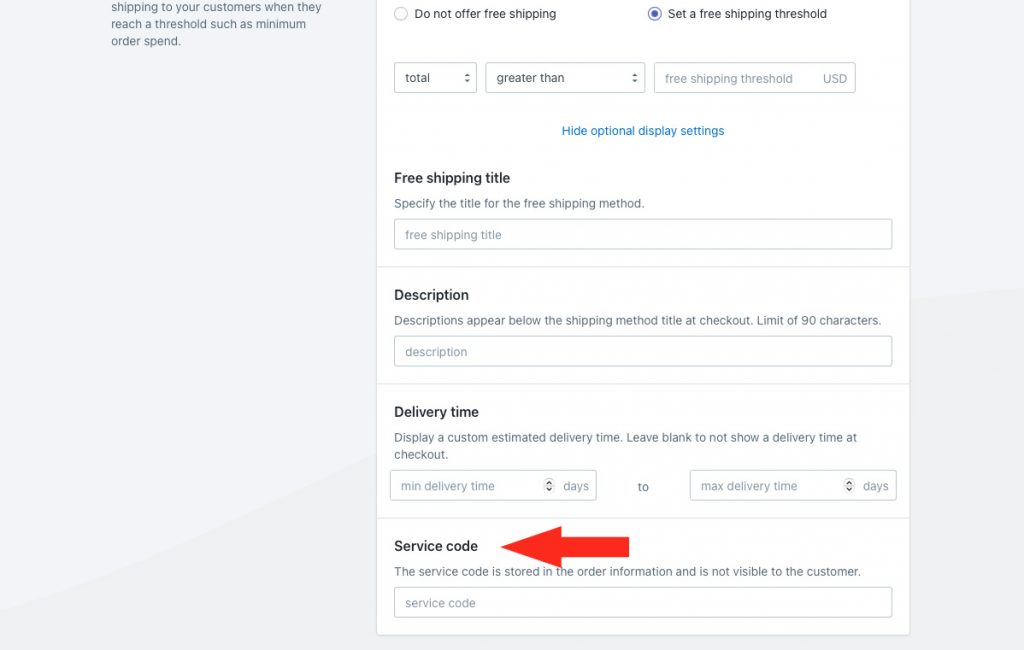
Custom Shipping Blending
If you have products with custom shipping costs, those product-specific rates can be blended with your live carrier rates.
For example, if a customer’s cart includes a product with a $100.00 custom shipping cost – meaning you always charge $100.00 to ship that product, regardless of what else is ordered – and this shipping method calculates a carrier rate of $27.55, the customer will be charged $127.55 for shipping at checkout.
If you don’t have products with custom shipping costs, these settings are ignored regardless of how they’re set. Skip ahead to Rate Blending. If you have products with custom shipping costs, continue to Step 1.
1) Select a custom shipping blending option.
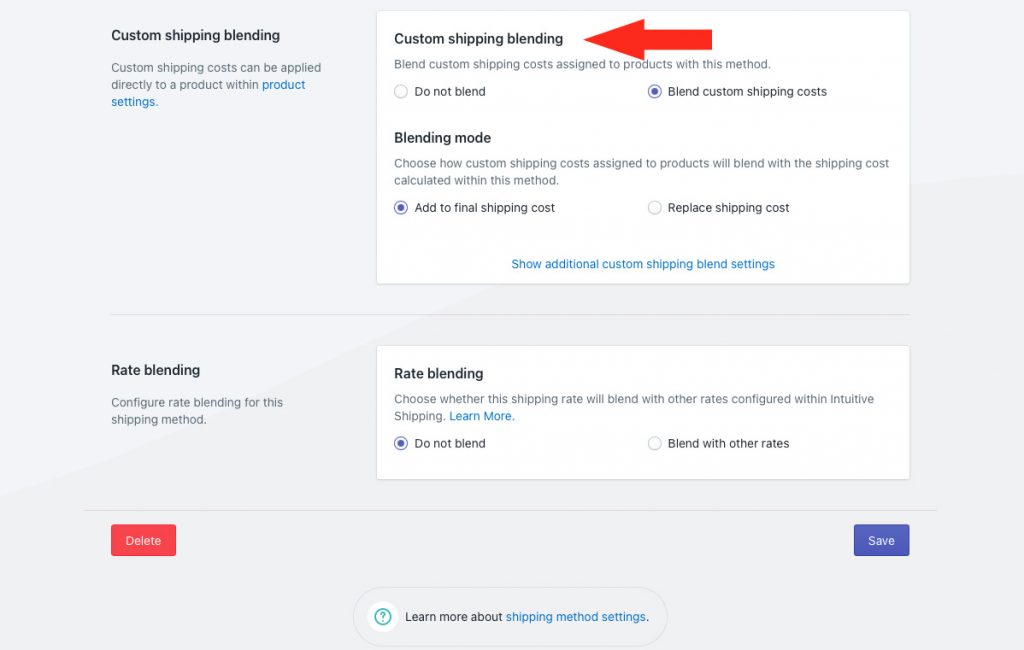
You have two (2) options to choose from:
Do not blend – custom shipping costs are ignored by this shipping method. For example, if you have a product with a $100.00 custom shipping cost, and this shipping method returns a carrier rate of $21.12, a customer ordering the product with the $100.00 custom shipping cost will only be charged the carrier rate of $21.12 for shipping at checkout.
This setting is useful if you want to charge custom shipping costs when a customer orders only those products, but charge ‘standard’ carrier rates from this shipping method when the customer combines their order with other products.
If you choose this setting, skip ahead to Rate Blending.
Blend custom shipping costs – custom shipping costs are blended with this shipping method based on the setting selected in Step 2. This is the default setting.
2) Select a blending mode.
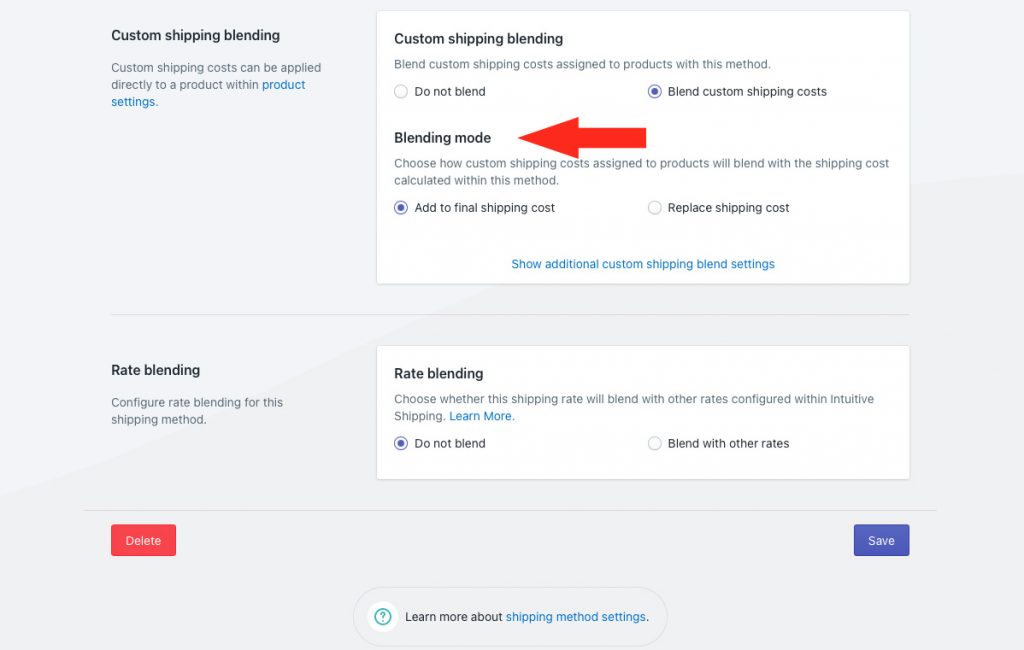
You have two (2) settings to choose from:
Add to final shipping cost – custom shipping costs are added to the carrier rates calculated by this shipping method. For example, if you have a product with a custom shipping cost of $250.00 and this shipping method calculates a carrier rate of $51.50, the customer will be charged $301.50 for shipping at checkout.
Replace shipping cost – custom shipping costs replace the shipping costs calculated by the shipping method. Using the same example as above, the customer will only be charged $250.00 for shipping at checkout.
Additional custom shipping blending settings are available for a filtering, mark ups and discounts.
If you don’t need to filter or apply cost adjustments to products with custom shipping charges, skip ahead to Rate Blending. Otherwise, continue to Step 3.
3) Click Show additional custom shipping blend settings.
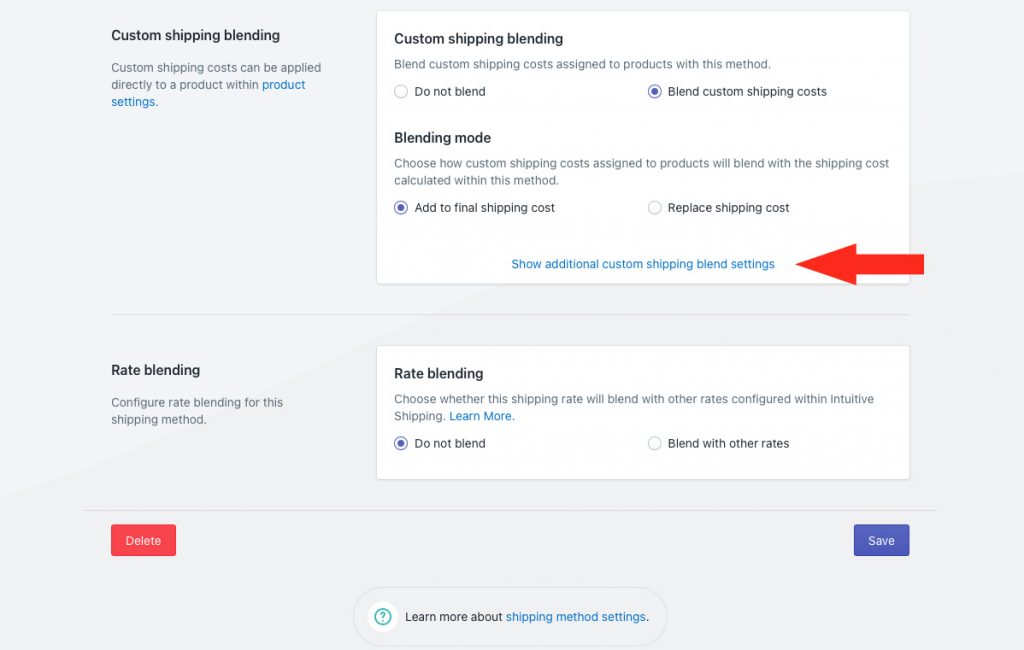
4) Select a filter products option.
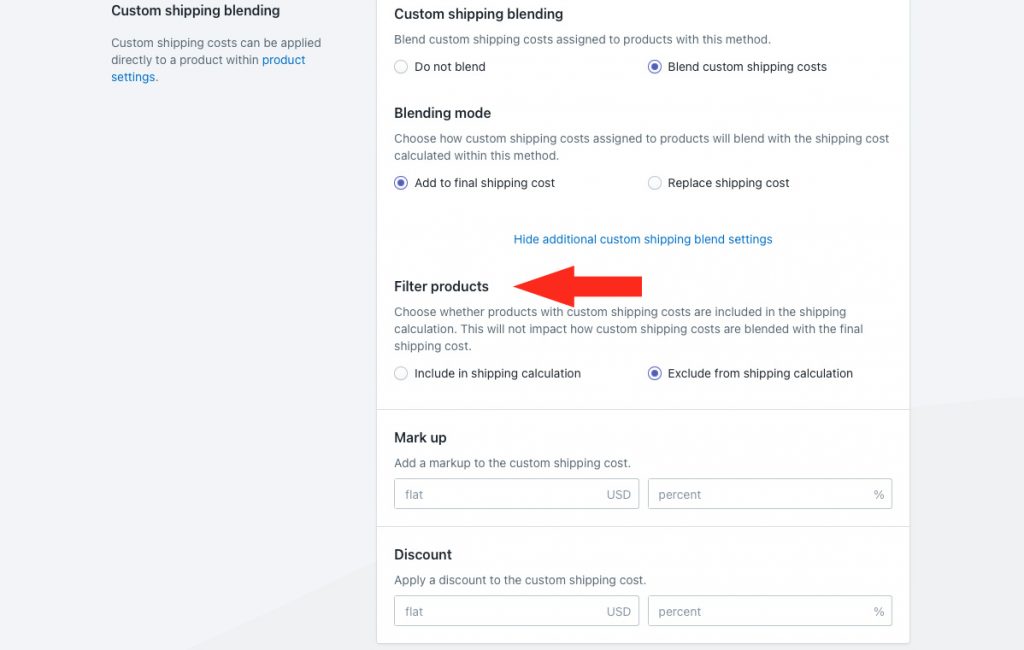
You have two (2) settings to choose from:
Include in shipping calculation – products with custom shipping costs will be included in the rate calculation. The product weight and dimensions will be included in the packing algorithm and added to the overall package information sent to the carrier.
Exclude from shipping calculation – products with custom shipping costs will be excluded from the rate calculation. The product weight and dimensions will be ignored by the packing algorithm and excluded from the overall package information sent to the carrier.
5) If desired, add a mark up to the custom shipping costs.
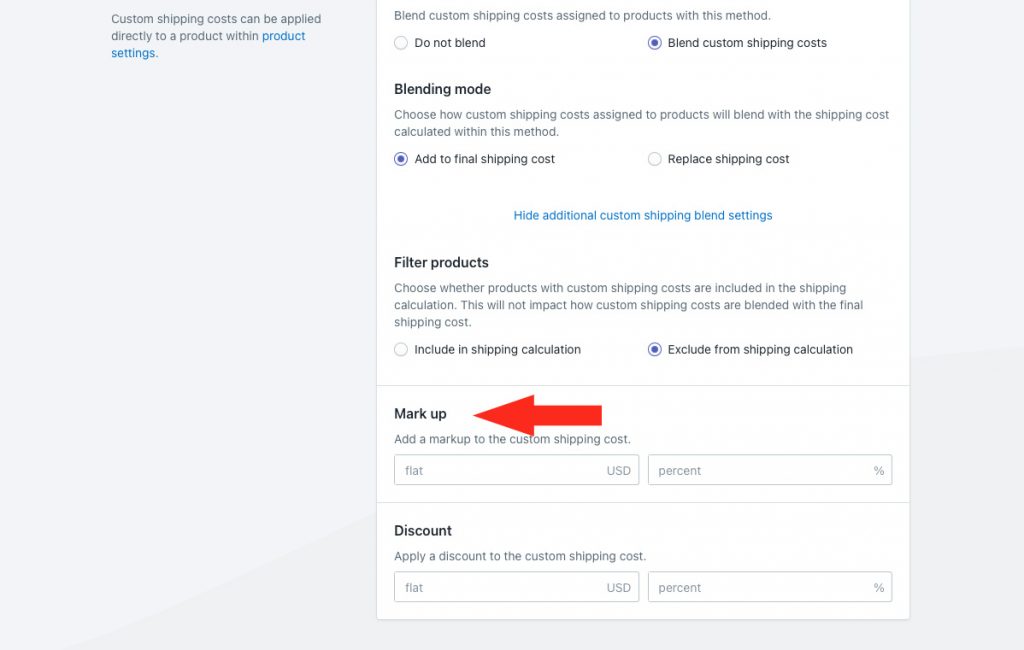
You have two (2) settings to choose from:
Flat – when there are products with custom shipping costs in the cart, the flat amount will be added to the total custom shipping costs. The combined total custom shipping cost, including the flat mark up, will then be blended with the carrier cost calculated by this shipping method, depending on the Blending mode settings in Step 2.
Let’s say you have 2 products with custom shipping costs of $50.00 and $30.00 respectively, and you add a $10.00 mark up. The combined total of $90.00 is then blended with the carrier cost calculated by the shipping method.
Percentage – when there are products with custom shipping costs in the cart, the percentage of combined custom costs will then be added to the original combined amount. The adjusted cost, including the percentage mark up, will be blended with the carrier cost calculated by this shipping method, depending on the Blending mode settings in Step 2.
Using the same example as above, if you add a 10% mark up (instead of a $10.00 mark up), the custom shipping cost will be adjusted to $88.00 ($80.00 + 10% of $80.00). The adjusted cost of $88.00 is then blended with the carrier cost calculated by the shipping method.
Using the same example as above, if you add a $10.00 flat mark up as well as a 10% percentage mark up, the custom shipping cost will be adjusted to $99.00 ($80.00 + $10.00 = $90.00, plus 10% of $90.00). The adjusted cost of $99.00 is then blended with the carrier cost calculated by the shipping method.
6) If desired, add a discount to the custom shipping costs.
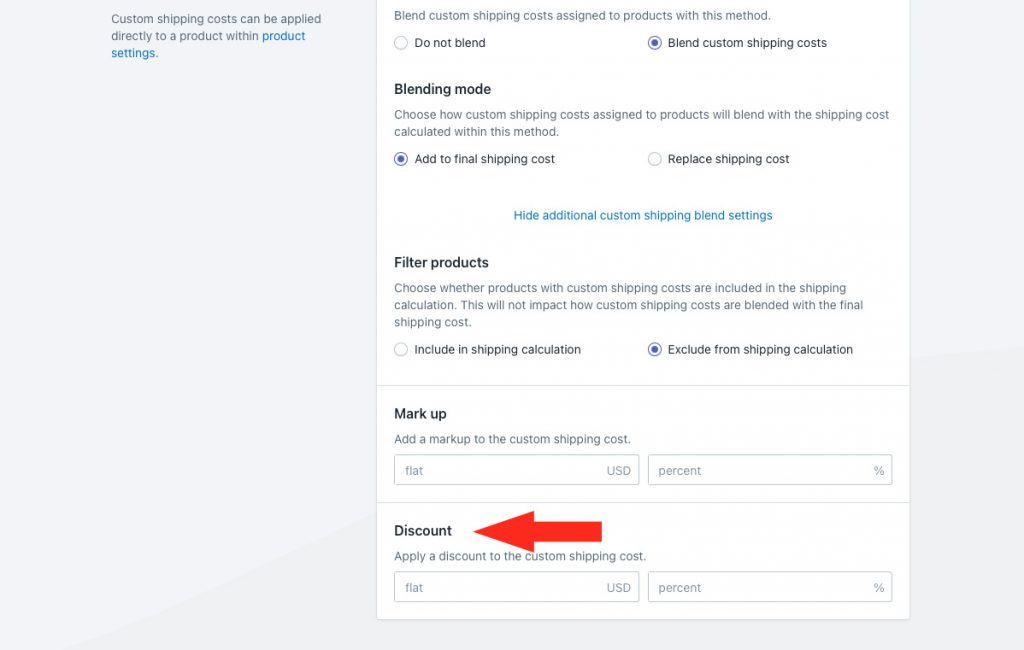
You have two (2) settings to choose from:
Flat – when there are products with custom shipping costs in the cart, the flat amount will be subtracted from the total custom shipping costs. The combined total custom shipping cost, including the flat discount, will then be blended with the carrier cost calculated by this shipping method, depending on the Blending mode settings in Step 2.
Let’s say you have 2 products with custom shipping costs of $50.00 and $30.00 respectively, and you apply a $10.00 discount. The total combined custom shipping cost will be adjusted to $70.00. The adjusted cost of $70.00 is then blended with the carrier cost calculated by the shipping method.
Percentage – when there are products with custom shipping costs in the cart, the percentage of combined custom costs will then be subtracted from the original combined amount. The adjusted cost, including the percentage discount, will be blended with the carrier cost calculated by this shipping method, depending on the Blending mode settings in Step 2.
Using the same example as above, if you apply a 10% discount (instead of a $10.00 discount), the custom shipping cost will be adjusted to $72.00 ($80.00 – 10% of $80.00). The adjusted cost of $72.00 is then blended with the carrier cost calculated by the shipping method.
Using the same example as above, if you apply a $10.00 discount as well as a 10% percentage discount, the custom shipping cost will be adjusted to $63.00 ($80.00 – $10.00 = $70.00, less 10% of $70.00). The adjusted cost of $63.00 is then blended with the carrier cost calculated by the shipping method.
You can even apply both a mark up and a discount to custom shipping costs, if desired. The mark up is applied to the custom shipping cost first, followed by the discount.
Using the examples above, if you add a 10% mark up as well as a $10.00 discount, the custom shipping cost will be adjusted to $78.00 ($80.00 + 10% of $80.00 = $88.00, less $10.00). The adjusted cost of $78.00 is then blended with the carrier cost calculated by the shipping method.
Rate Blending
If you have multiple Scenarios – perhaps you have a mix of parcel services and custom services depending on the product – you can decide if those rates should be blended together or not.
For example, if one product type has a flat rate shipping cost of $10.00 and another product type has a live carrier cost of $27.50, rate blending can add those two costs together when a customer orders both product types.
If you don’t have rates that need to be blended, leave rate blending set to the default ‘Do not blend’, and skip ahead to Save Your Settings. Otherwise, continue to Step 1.
1) Select Blend with other rates.
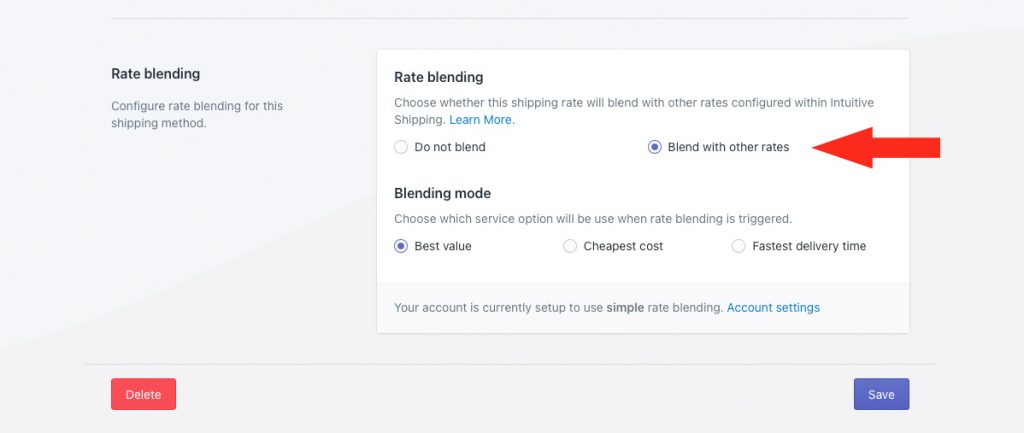
2) Choose a blending mode.
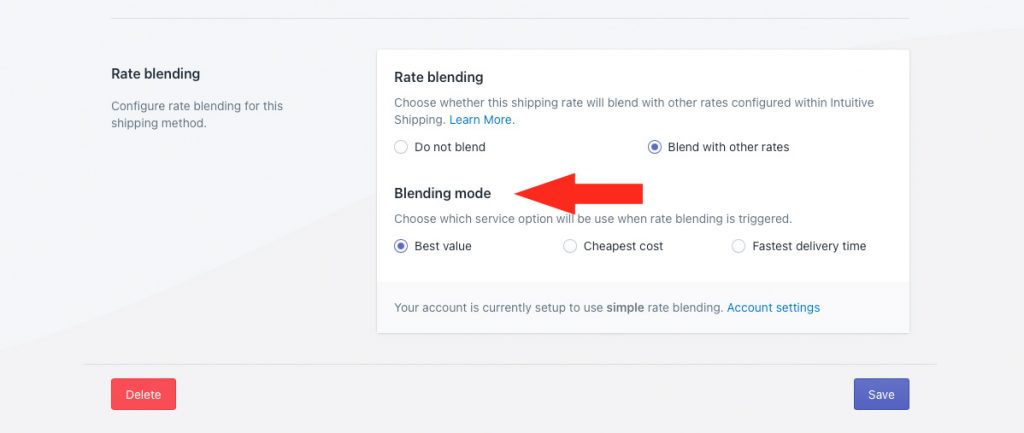
You have two (3) settings to choose from:
Best value – the carrier service from this shipping method with the best overall value is blended with other rates.
Cheapest cost – the carrier service from this shipping method with the cheapest cost is blended with other rates.
Fastest delivery time – the carrier service from this shipping method with the fastest delivery time is blended with other rates.
By default, Intuitive Shipping is set to simple rate blending.
If you have not adjusted your account settings for rate blending, the message ‘Your account is currently set up to use simple rate blending’ will appear at the bottom of the Rate blending section.
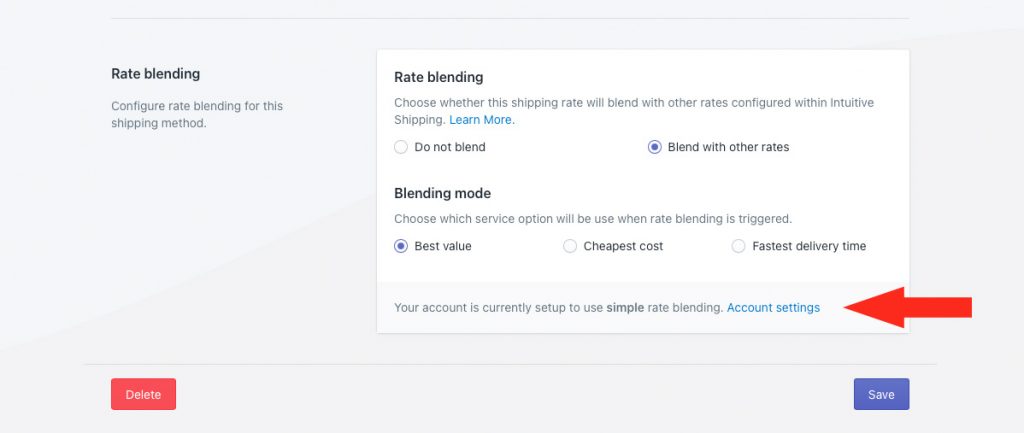
If you previously adjusted your account settings for advanced rate blending, the message ‘Your account is currently set up to use advanced rate blending’ will appear at the bottom of the Rate blending section, along with a setting for Blending groups.
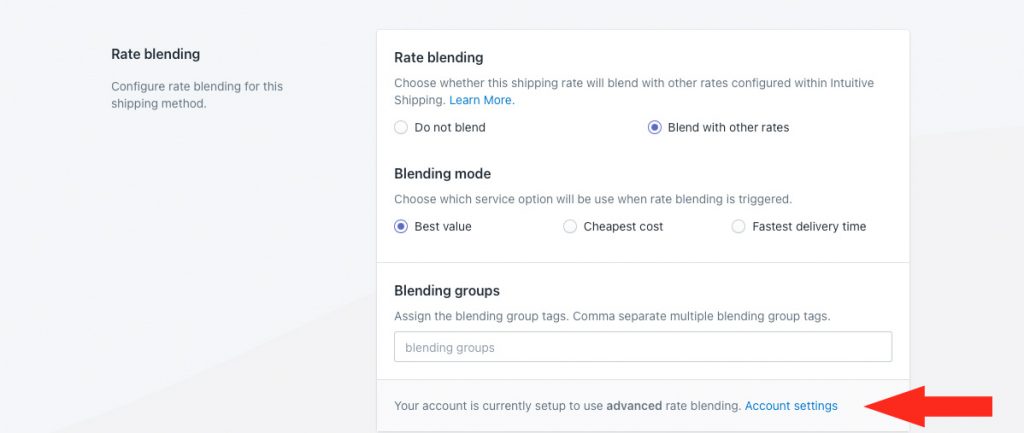
If you’re using simple blending, skip ahead to Save Your Settings. Otherwise, continue to Step 3.
3) Add a Blending group tag. All shipping methods with the same blending group tag, regardless of the type of shipping method, will be blended together by the Blended rate.
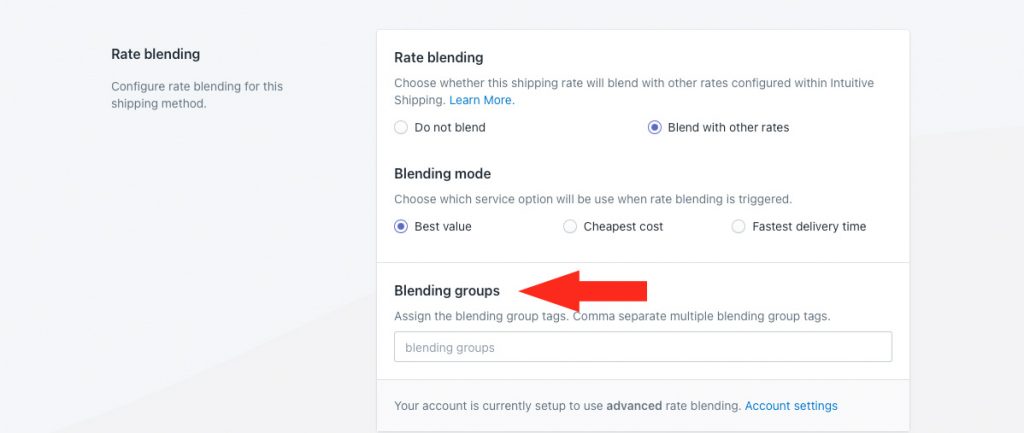
Save Your Settings
1) Click the Save button to save your parcel service shipping method.
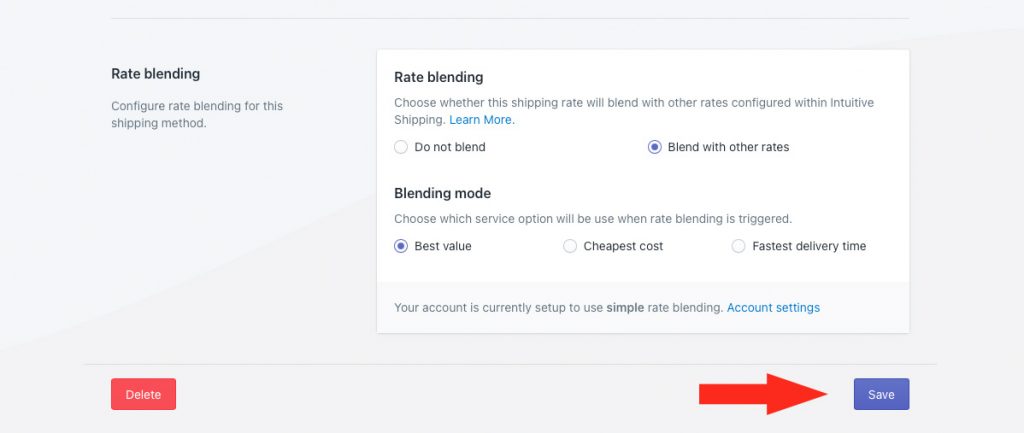
What’s Next:
Update product settings or create a custom service shipping method.
Check out our common setups and additional setups sections for setup ideas.
